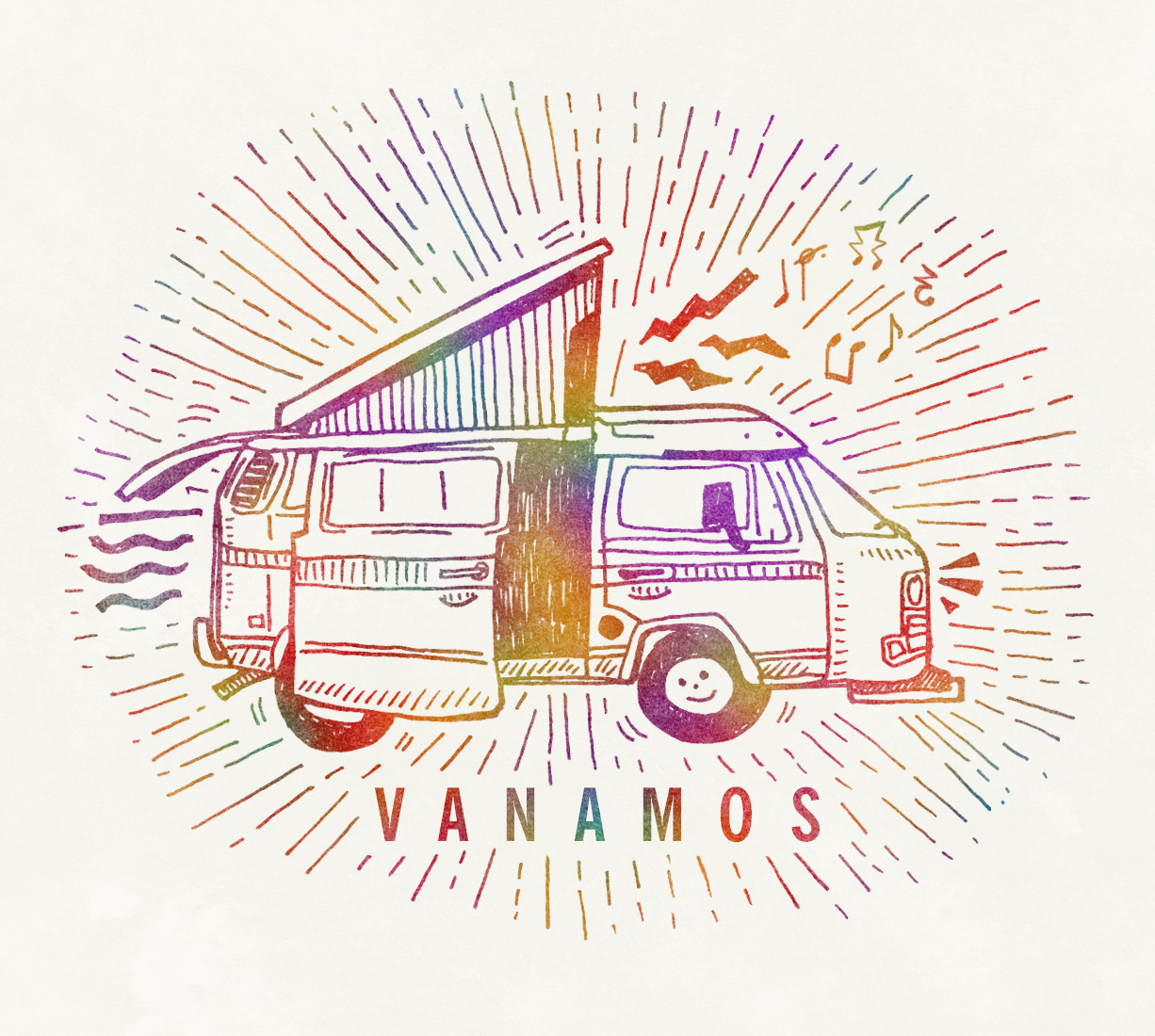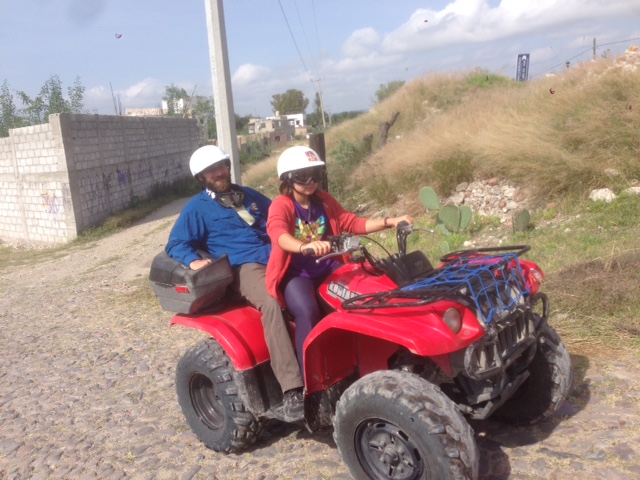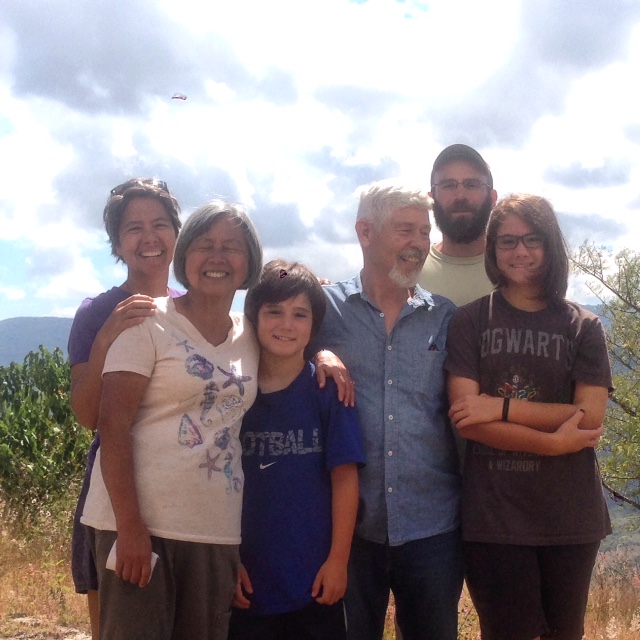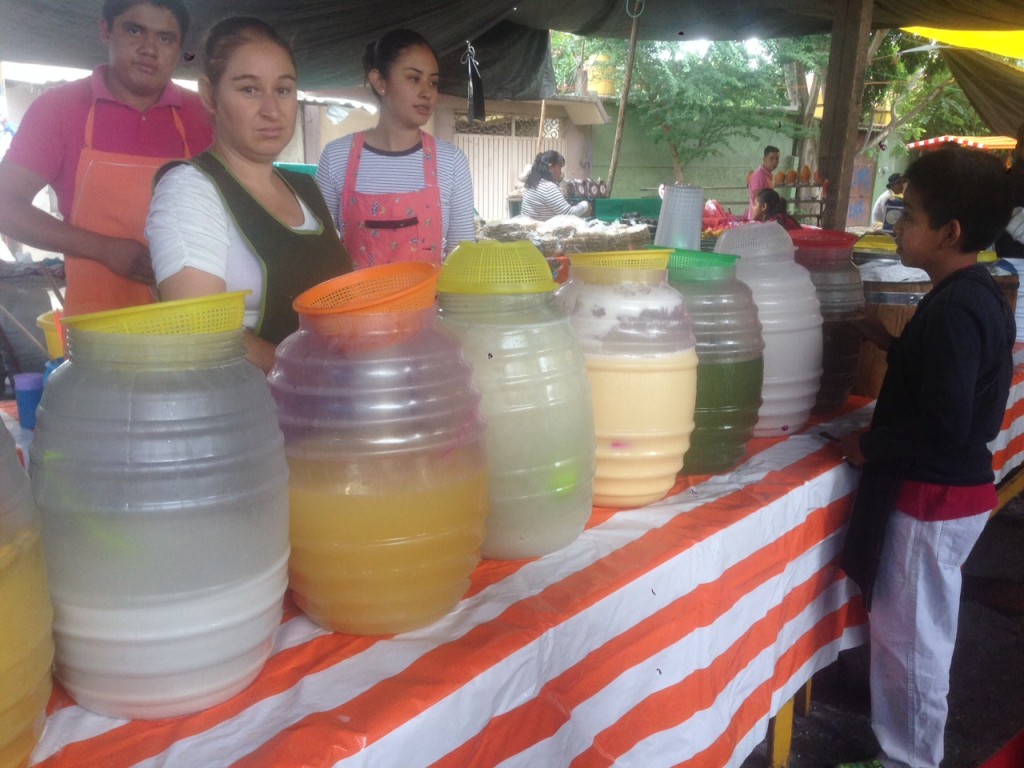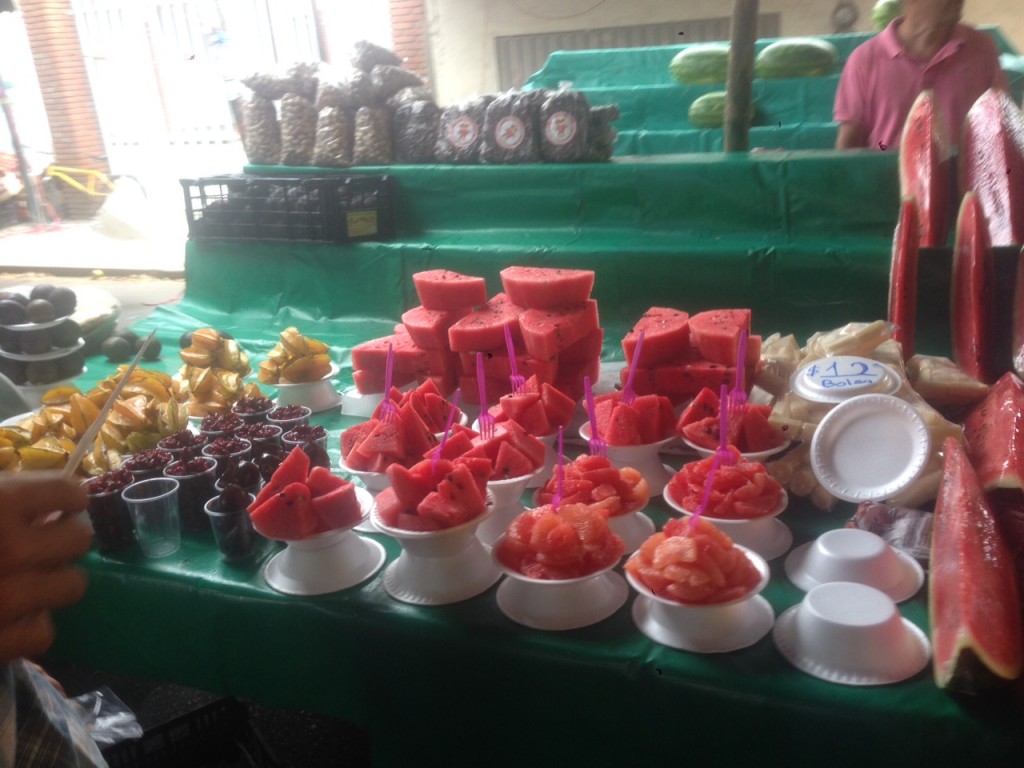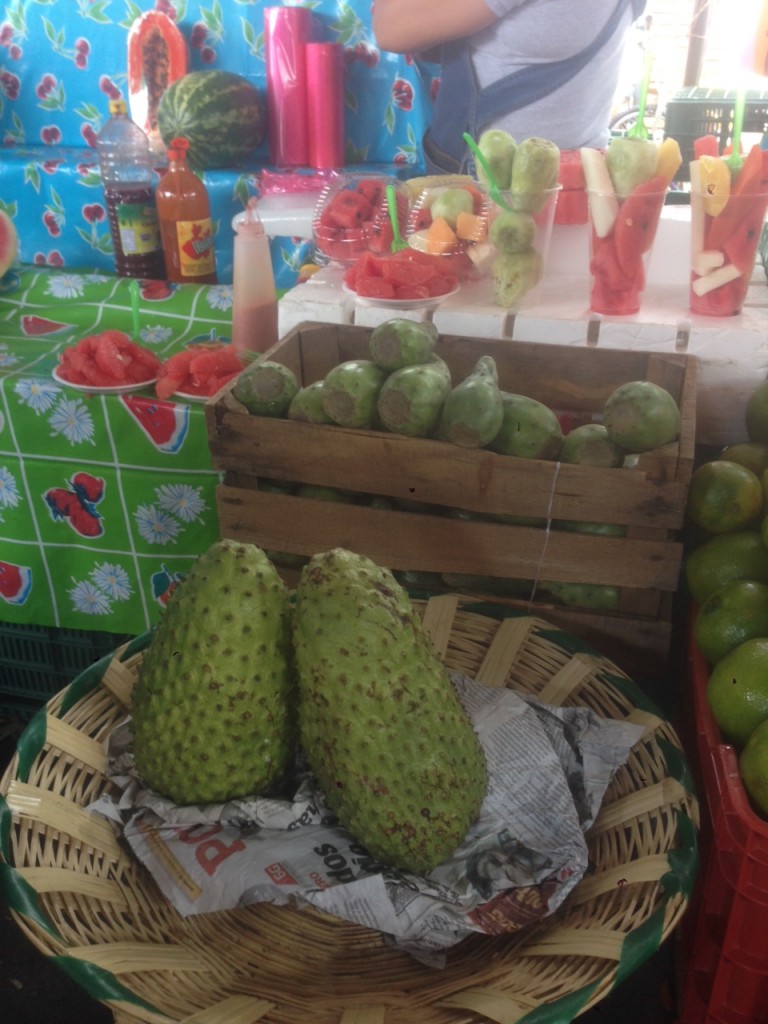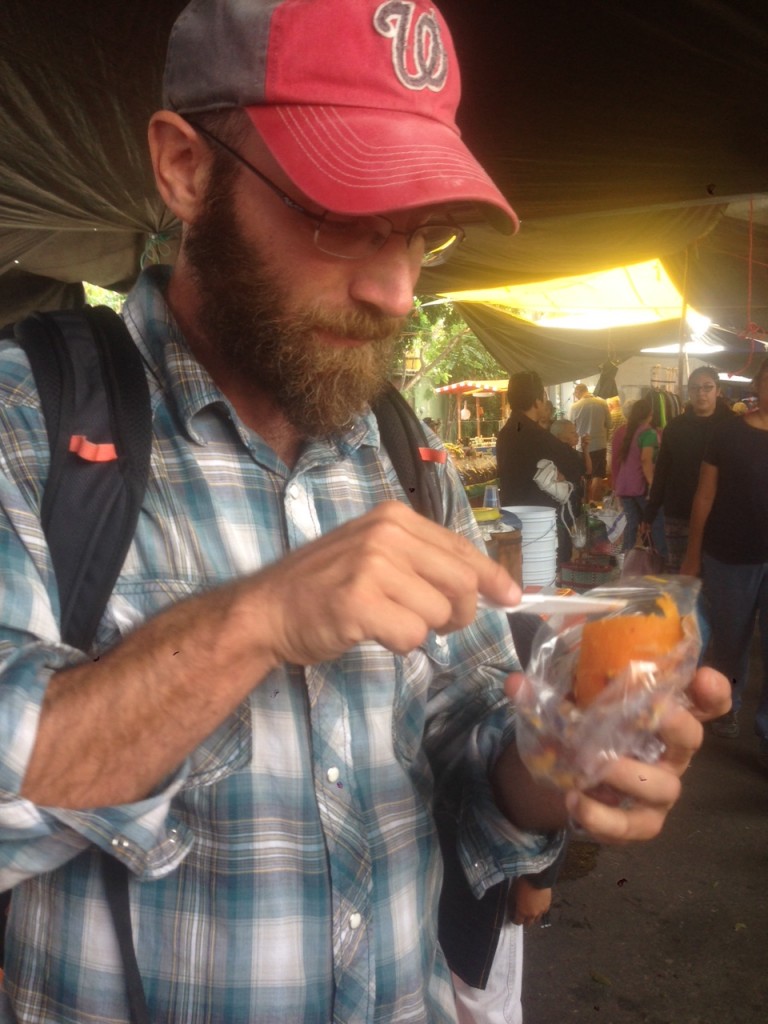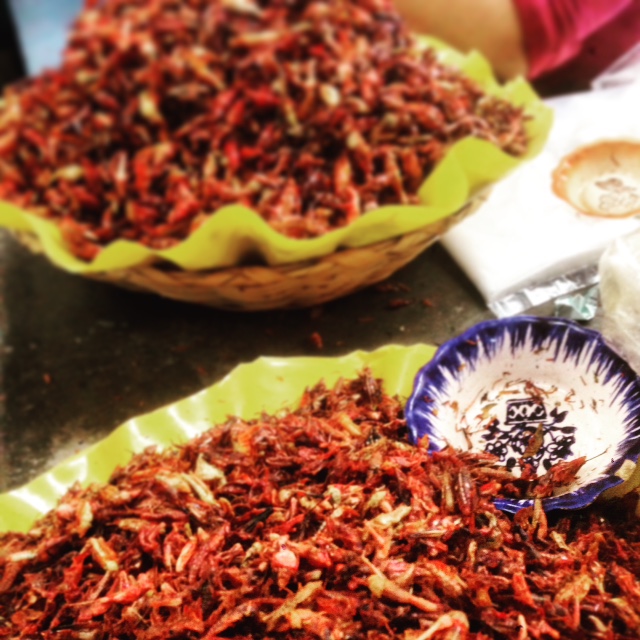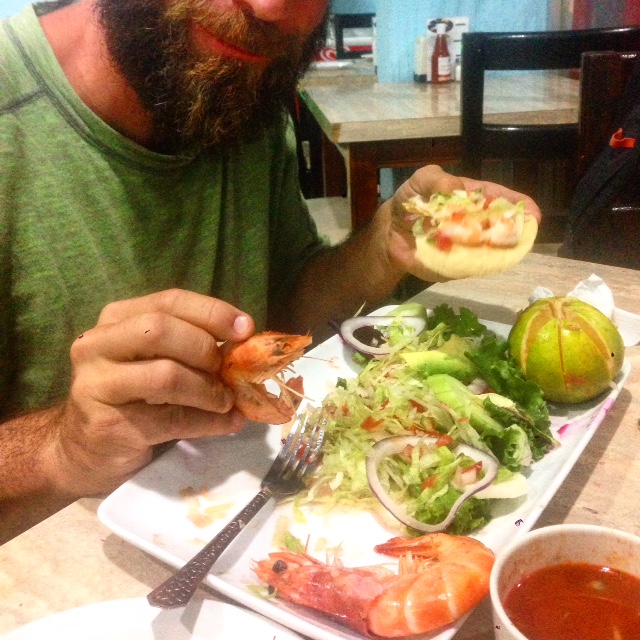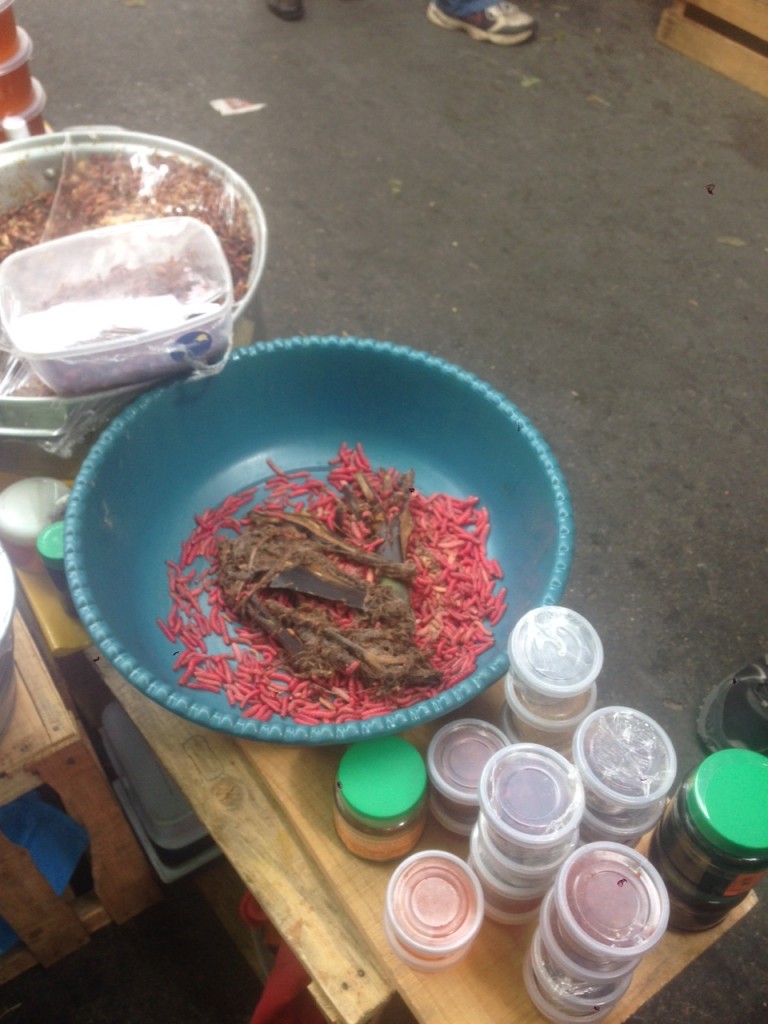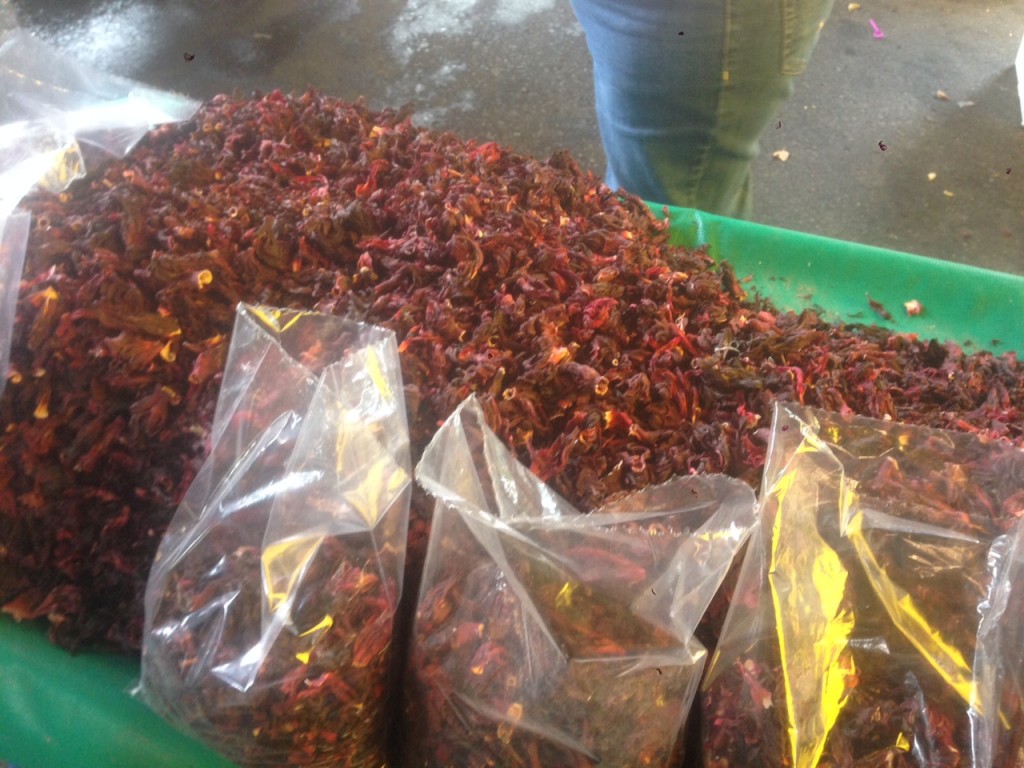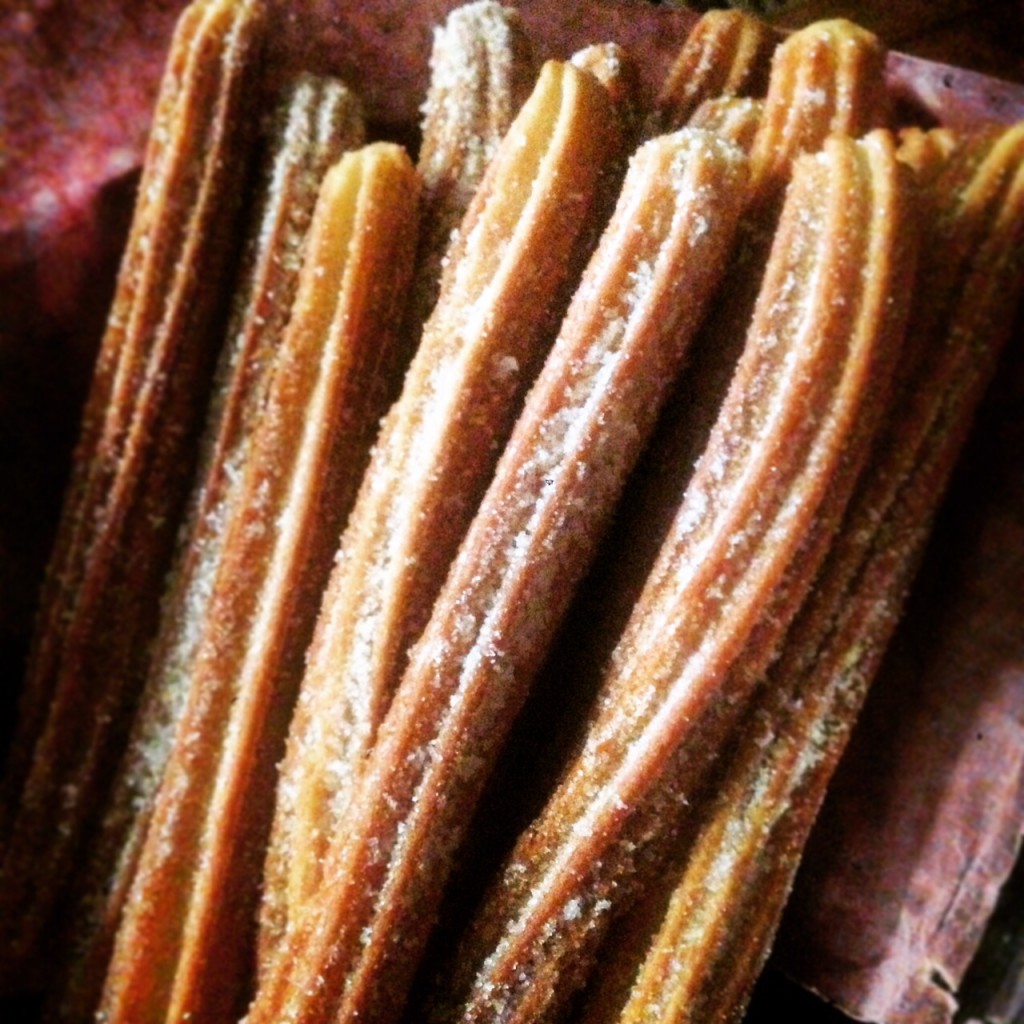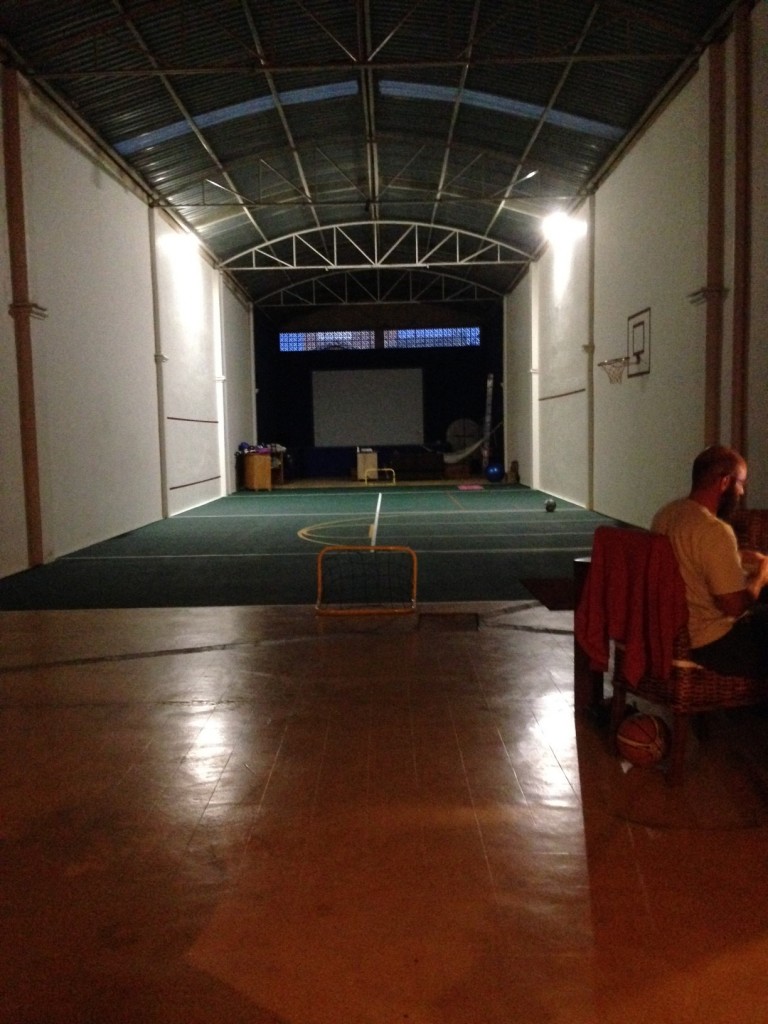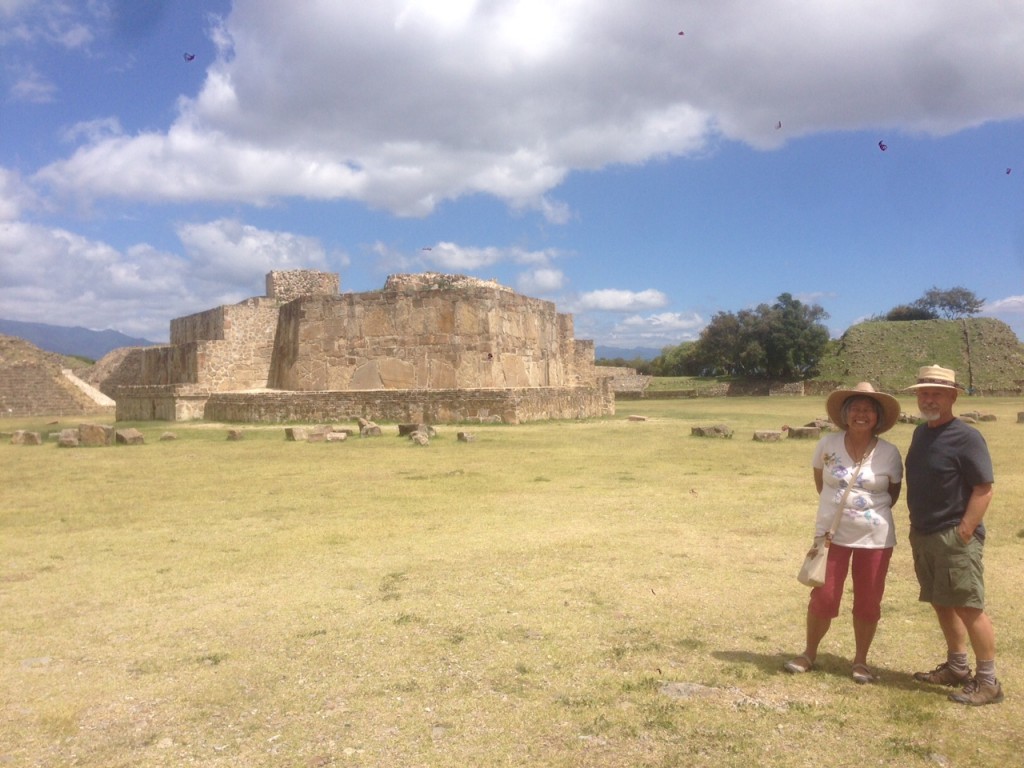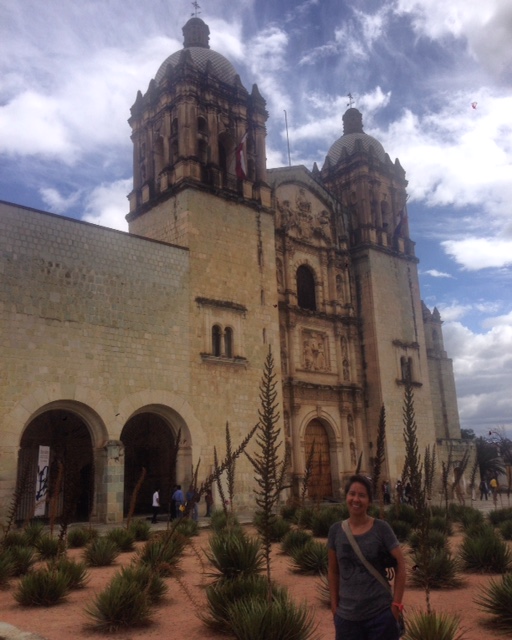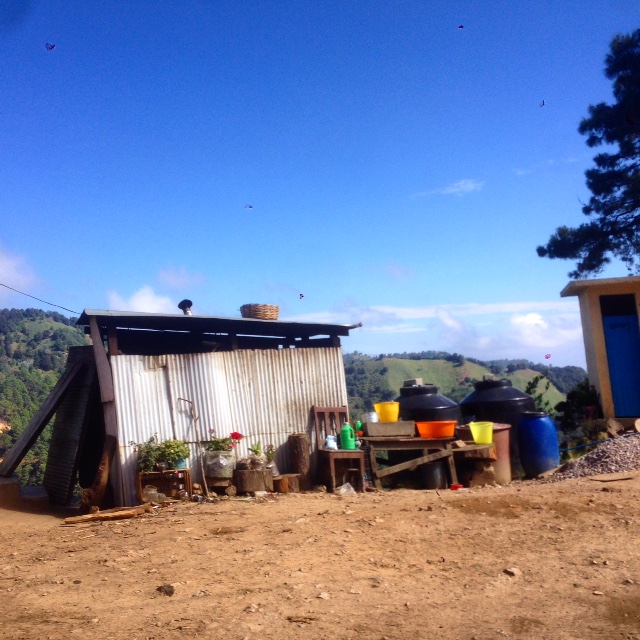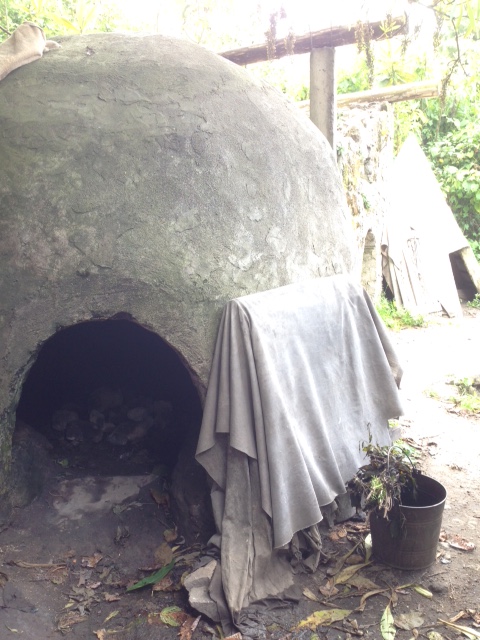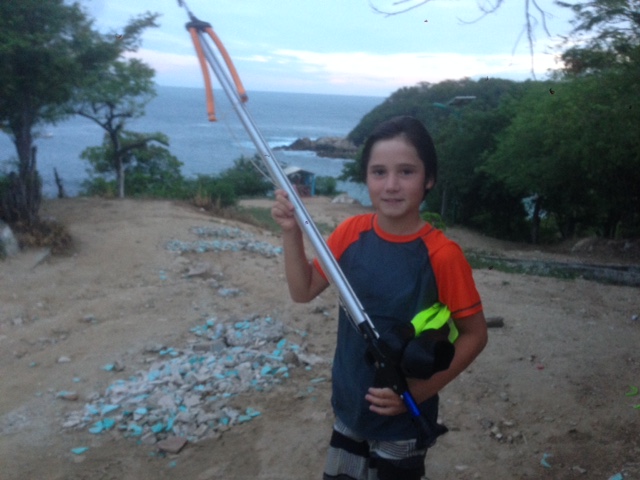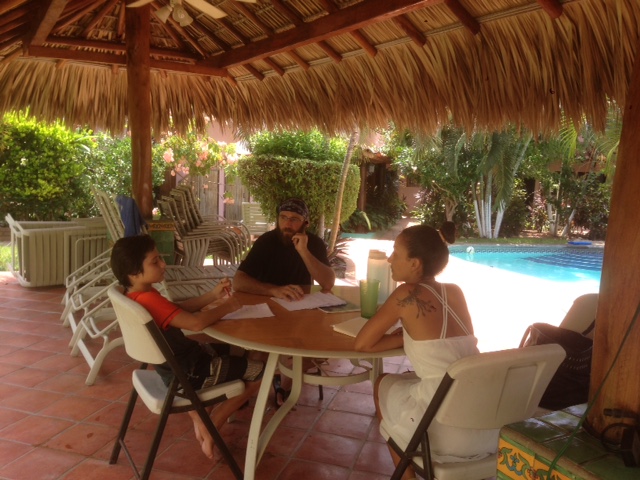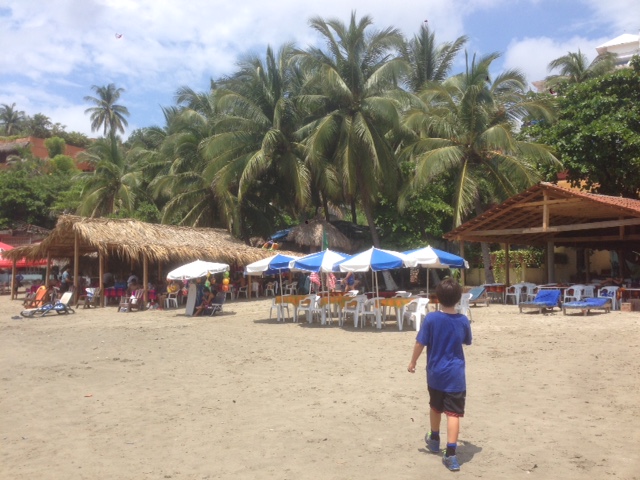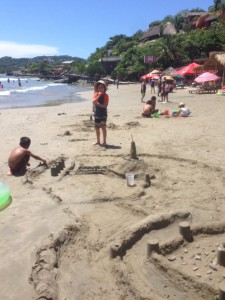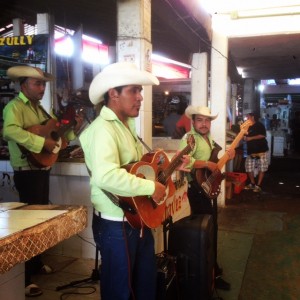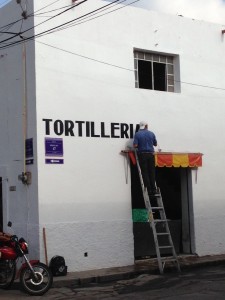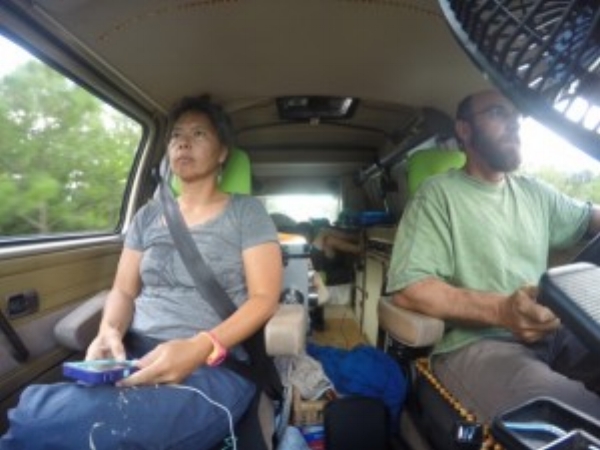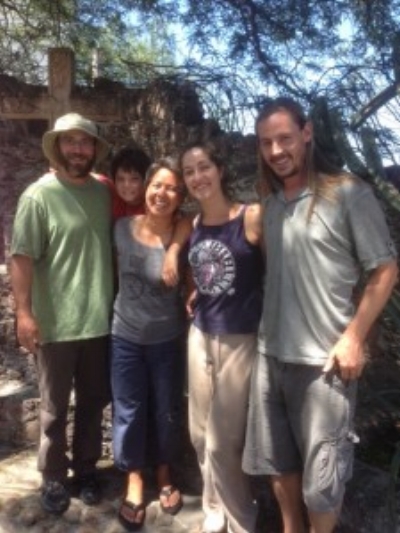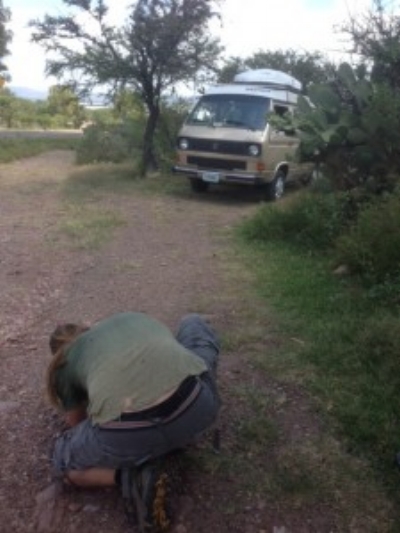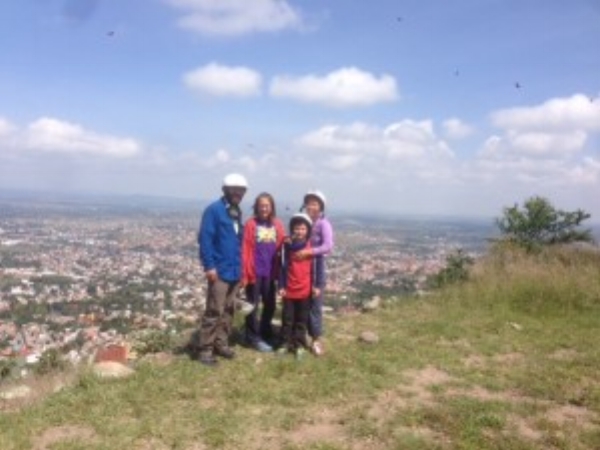We decided to pull up the parking brake in Oaxaca for the month not only because it’s fun to say that you are in Wa-ha-ka (the phonetic pronunciation of Oaxaca) but also for the Dia de Muertos (Day of the Dead) celebration. The Day of the Dead is a Mexican tradition occurring on November 1 or November 2 - we haven’t been able to figure out which of the two days is the actual Day of the Dead - where the living relatives of a dead person celebrate the dead person’s life by pulling weeds that have grown up around the grave of the dead person since the last time the living people - who are busy all year doing things that living people do like riding motorcycles - visited a year ago, decorating the grave site of the dead person with flowers and art, drinking mezcal, and passing out in the cemetery. The Day of the Dead ritual has its religious origins in Mexican colonial times when the Catholic Church tried to meld indigenous beliefs with its own recognition of All Saints’ and All Souls’ Day, but has been commercialized to the point that you can buy cotton candy and light-up neon circus toys while urinating in the corner of the cemetery. I’m just saying.
How Frank Zappa educated my children
My Mom was a teacher. Her daddy before her was a caddy master at a golf course and her mom sold cosmetics. My Dad worked on Wall Street and his parents weren’t teachers either. R’s father is of Mormon heritage and her maternal grandfather had three wives simultaneously. There’s a lot of mystery, intrigue, aunts, uncles, and cousins on her side of the family. None of them are teachers. We come from a long line of non-teachers and Coconut and J were quick to call our bluff. “You’re not my teacher”, they said when we tried to teach them the things we told the Alexandria City Public School system that we would teach them in this year of homeschooling so that they could be placed into an age appropriate grade whenever we get back to that version of reality. Though, looking on the bright side of failure, J may be able to drive himself to middle school, which would save R and me some time in the mornings.
We’re both pretty smart people though, R and I. We’ve been around the block a few times - R a few more times than me given her advanced age. Since both our kids were reading above grade level and were selected for advanced placement math when we took them out of school for this trip, I proposed we could surrender on the education front and when we re-enrolled Coconut and J in public school the other kids in their age group would hopefully have caught up. While that would be a nice, easy solution to eliminate the daily stress R and I experience trying to get Coconut and J to do a math lesson or write in their journal instead of watch 6 consecutive episodes of The Amazing Spiderman cartoon before 9 a.m., R convinced me that it was an abdication of parental responsibilities. That’s why we’ve agreed to rely on others to educate our children.
Coconut and J learned from the Frank Zappa song “Why Does it Hurt when I Pee?” about sexually transmitted diseases and we’ve now enrolled them in a project-based learning school in San Felipe del Agua, just north of Oaxaca City, where over the next month, they will have social interaction with children their own age, eat peanut butter and jelly sandwiches, and decide whether or not they like the color yellow.
All it took to enroll them for the month was some money and they started that day - no transcripts, placement tests, health records, or questions about allergies. Mexico is so simple! And to put a grand finale on their first week of school, they got to walk around town in a parade led by a professional brass band in celebration of the Day of the Dead. R and I could not have topped that in our version of school.
Everything that we read before leaving on our trip (when I say “we read”, I mean that R read the articles and forwarded them to me where they piled up in my inbox) about road-schooling - a version of homeschooling performed in the back seat of some type of wheeled vehicle - condemns the rote structure of the traditional classroom learning experience where children are told how, where, and when to learn certain subjects, and are held back by their peers who learn at a much slower pace (i.e., they’re borderline dumb), and trumpets the virtue of taking the child out of the classroom and letting his or her natural inquisitiveness with regards to a particular thing dictate the learning process - even if that interest is imagining the offspring of two extinct species of fish.
We read about road-schooled children - world-schooling is another kitschy name that people use to try to get you to read their blog where they sell space to companies trying to capitalize on the growing world-school market - who willingly do science or creative projects, “collect” photos of historical buildings or fancy churches they’ve seen, and go on hikes or bike rides through nature that doesn’t exist in a Minecraft world. My kids don’t do anything willingly, but I shuddered to think what level of greatness I could have reached if only I had been released from the drudgery of classroom learning and left on my own to pursue my real passion - idealizing Old West gunfighters. Alas, it was college and law school for me, and a stack of Weird Western Tales comic books.
Now, us road-schoolers, (I use that term loosely as it regards myself) recognize the value of knowing addition, subtraction, and using the proper verb tense when speaking, and we have the same hopes for our children that our parents had for us - love, health, happiness, and beer money. The difference is we are more in tune with the research, numbers, and hypotheses that tell us the right way to achieve those things.
To be brutally honest - which I am sometimes too much so, to the point of being offensive - I don’t think the decision we road-schoolers make to pull our children out of the traditional American education system for a lesson in comparative analysis of traffic signs is completely borne of wanting what is best for our children. Some of it must be motivated by self-interest - we’ve been sitting behind a desk for the last pick a number of years while the days of our lives tick by without us being fully engaged. It’s depressing to think that meeting a deadline is all life has to offer for those of us who have always daydreamed about some kind of nomadic existence. As a kid, I used to watch the medians between highways on car trips thinking about whether it would be a good campsite, by criminies! I’ve spent too much of my adult life where the highlight of my year was receiving the revised edition of the Internal Revenue Code. Enough!
Nevertheless, despite this trip being perhaps R’s and my idea of a good time more so than Coconut and J’s, R and I have spent a good deal of time discussing whether what we are doing is in the best interests of the kids. Yeah, we had those conversations before we left on the trip too, but we got caught up in the articles we read about how an iPad is a tool for learning and not just for playing Asphalt 8 (not in this family!) and how much fun it is to learn math by converting foreign currency into dollars and kilometers into miles (combined, these “lessons” took about two minutes before the kids got it.)
We didn’t put the pieces together and figure out if the style of self-motivated learning was a fit for our children. Maybe we didn’t know our children that well (we thought they had interests!), or maybe it’s too soon to say whether the model is a success or failure for us, but so far, the picture that we are drawing of road-schooling looks like something a preschooler would do - there’s a lot of coloring outside the lines. It could be us too. Maybe we are too caught up in "book-learning" and our expectations of what road-school is supposed to be were something different than how things have turned out so far. Because, looking back over our three months, we've done some pretty cool things that we may not have had time, opportunity, or money to do back home, and from which they might have learned something.
So, road-school, we haven't given up on it. But after three plus months on the road, we wanted to stop and reintroduce the kids to something more familiar to them - classroom learning with their peers. R and I also needed to catch up on our afternoon naps.
Before we left on this trip, someone asked me what I hoped to gain from it. I answered, perspective. R and I want the kids to understand that what they see and hear and know in Alexandria, or in the U.S., is not the only thing that they can see and hear and know, and that different things are important to people in different ways and for different reasons. Basically, we want them to try and live by accepting things for what they are, and to be who they are. As Frank Zappa sings, “Who cares if you’re so poor you can’t afford to buy a pair of mod a go-go stretch-elastic pants. There will come a time when you can even take your clothes off when you dance.” In other words, differences don’t mean one way is right and one way is wrong, unless you are planning to vote for Donald Trump for president. That’s just wrong.
So, perspective on the world is one lesson we want them to learn, and perhaps just exposure will enable them to think this way. Being in a school with kids in Oaxaca, Mexico, will give them perspective. The other lessons we want them to learn are those that will get them a high school diploma.
Road-schoolers do not test because it is a false measure of intelligence and categorizes kids as either smart or dumb, which could damage their confidence and discourage them from thinking of learning as a joy, so it is hard to gauge what Coconut or J have absorbed substantively from our three months on the road. We didn’t think Coconut was paying any attention at all when we went to the Martin Luther King, Jr. museum or the other sites we visited during our Civil Rights tour through Atlanta, Alabama, Mississippi, and Memphis, but then one day weeks later she compared teacher strikes going on in Mexico for equal pay and working conditions to the U.S. civil rights movement. Cool!
There was a lot of U.S. and Mexican history printed onto the walls at the Alamo which Coconut and J were too bored and hot to read, but J took an interest in James Bowie and his knife, and when we googled those things later, we learned that Bowie wasn’t quite the hero we thought he was going to be, though he did get stabbed and shot about twenty times at the Sandbar Fight without dying so whatever else he was, we know he was pretty damn tough. We also learned that a Bowie knife is sharp on both sides of the blade, among other features. Padrissimo!
We saw in Dolores de Hidalgo that Mexico has its own story of revolution for liberty from foreign oppressors, and Coconut noticed that the heroes and villains in that history have streets in every major city and minor village named after them, and we learned at the archaeological sites of Monte Alban and Yagul that there was a rich cultural and spiritual (and violent!) pre-hispanic society in Mexico to rival any in the world at the time. We also learned a heck of a lot about sea turtles. Chido!
Maybe in twenty or thirty years Coconut and J will remember some details about these things, or maybe they’ll just have an inkling of the concept, or have forgotten everything. Who knows? Sometimes they don’t appear to be enjoying what we are doing - we know this because we can read their cues, usually preceded by something along the lines of “when are we leaving?” - and R and I think we are failing them. But then everyone that we’ve talked to whose parents did this to them in their youth, before road-schooling was a term of art, look back on the time fondly now that they are adults, so we are hoping that whatever anguish Coconut and J are feeling now will be recalled positively. As evidence this is possible, J said this week that he remembered his preschool days as a fun time, which was good because what R and I were afraid he would remember was that he cried every day at drop off for his entire three-year preschool career. Anyway, I told them the two most important things for them to do this month are 1) stay alive, and 2) learn to speak Spanish. They both laughed, so at least I know they were listening.
These places of water
We bounced into Hierve el Agua, a series of bathing pools set atop a frozen waterfall, after winding 10 kilometers along a dirt road with spectacular views of agave-strewn hillsides, and enough up and down to make we wonder if Wesley had the power to make it back out again. While Coconut and J were excited to be able to wear their bathing suits again after an extended break, R and I were stoked to get back to camping, so despite the instructions from the guy pocketing our entrance and camping fee to park on one side of the place, we decided to set up camp on the other side of the place because we could get closer to the cliff edge and have a better valley view and also we were closer to the cabana that Opa and PoPo rented.
The bathing pools are filled with mineral-laden natural spring water. As it bubbles and spills over the curves and dips of the ridge, it evaporates and leaves behind the minerals which harden into bone-like spines and ripples. The texture and shape of the rock formation of the main pool, is so rounded, smooth, and creamy-looking that you feel like you are swimming in a cupcake. As the water has trickled over the cliff face for millennia, it has formed what appear to be frozen cascades, and trails lead down to the valley floor so you don’t have to fall over the edge to get a look at this unique natural occurrence. The pools set on top of this cliff top, with views extending over valleys with dirt roads carved into them like stray strands of spaghetti, makes for one of the most spectacular and majestic places we’ve been so far.
The potential of this place as a capitalist venture is overwhelming. Think resort - glistening with restaurants, hotels, and chlorine pools, and supplemented with nostalgia hawkers, spas, hiking trails, and maybe even a golf course. Instead, besides the bathing pools, what’s on offer are overgrown and trash-strewn lawns, shacks stacked around the parking lot like a shanty town grown on the outskirts of the city from which vendors operate their food stalls and sell beer while the buildings meant to house restaurants and souvenier vendors sit vacant and neglected around the swimming pool which looks more like a museum exhibit of a polluted river - filled with brown water, plastic bottles and Dorito wrappers, sticks and leaves, and brown, shaggy things that look like doll-sized versions of Snuffleupagus from Sesame Street. If this place existed in the United States, it would have a fence around it with a no trespassing/danger sign posted every thirty yards.
Nevertheless, we loved it. This is Mexico, and we love that things are different. The view itself is worth the dollar price of admission, and one woman whipping up meals at her food shack made the best chorizo torta (sandwich) that I’m likely to ever have. As evening came on, the tour buses loaded up with day-trippers and headed back to Oaxaca, the food stalls were locked up, and we were left alone. As the valley darkened, a single homestead lit up over the miles and miles of mountainside making Hierve el Agua one of the most remote places we’ve been. And at about 8:30 p.m. when the school basketball game ended in the town spread through the hills above our cliffside camp, and the announcer turned off his microphone, it was also one of the quietest.
On Saturday, we broke camp and drove to San Felipe del Agua, a small village set in the foothills a few kilometers north of Oaxaca. San Felipe also has natural springs and is the site where the aqueduct that used to flow water to the city begins. We’ve enrolled Coconut and J in a school in San Felipe and R made an appointment for us to look at a house to rent. Then something happened that I don’t think could ever happen in the States - we looked at the place, liked it, and moved in - all within the hour. It helped that we had all our stuff in the van so moving in only took a few trips out the door and back again.
The house is relatively new so we can flush toilet paper down the toilet, and has three stories so we could each have our own floor if we wanted. As it is, we each have our own bedroom and bathroom. Having all this space would be a big deal if we had actually been living in Wesley the last few months instead of jumping from apartment to apartment. But it’s nice anyway, and if you were planning on coming to visit us, now would be a good time because we are going to be here for the month of November. The house has lots of natural light, and two spacious patios overlooking a bubbling brook that they call a river. J was excited that we would be able to fish the river, but then we saw it and realized that we would barely get our feet wet if we stood in it so we aren’t going to catch dinner, or even bait fish.
The place reminds me a bit too much of brick and mortar life, however, and sure enough, we spent the first days sweeping floors, hanging laundry, doing dishes, and going to Walmart. The nearest fruteria/grocery is a ten minute walk and there is no one across the street from us selling churros. In fact, there is no one in the street selling anything. The town has a bit of an uppity feel to it as well - it was described to us by one local in the city as the place where the rich gringos live - and all the shiny cars driving back and forth from the sushi restaurant have the windows rolled up and nobody seems to break a sweat, even those folks with their fluorescent sneakers and sweatsuits out for a jog. To remind us we are in Mexico, however, there is still dog shit everywhere and last night, there was a wedding celebration across the street that had the music volume turned up way louder and longer than it needed to be, and I am not just saying this because I am old. At one point, when we were still enjoying the party, J heard a song and said, “That’s my favorite Mexican song!”, so we all rushed over to the door and watched the people dancing and then as a testament to the volume of the speakers, we simply held up our phone to the street and after Siri identified the song, we rushed to the computer and watched the video on YouTube. It’s a song called “Madre Tierra (Oye)”, which means “Mother Earth (Listen)”, by Chayanne, who can’t dance based on his puny moves in the video, but we can relate to the lyrics which are in Spanish, but translate as upbeat and positive and encourage us to enjoy the good things that life offers. The video is also full of Mexican imagery like colonial buildings and beaches at sunset that I might have missed if I hadn’t been in Mexico for the last few months. Anyway, R posted a link on Facebook if you want to check it out.
And, in the spirit of being grateful for the good things in life, I want to relate my one positive association with dog shit. We were living in Quito, Ecuador, with Coconut, who was five. Every day we would be on this steep hill and Coconut would weave her Razor scooter around the many piles of dog crap set up like slalom gates on the sidewalk without losing her balance, and using the back brake to control her speed. I was so proud of her and it’s when I knew she was going to be able to ride a bicycle. Sure enough, when we got back to Alexandria later that summer, she nailed it on the first try. That’s a true story.
What we eat, again, and what we don't - Food in Oaxaca
I can probably count on one hand the number of times in my life that I have purchased a bottled juice like a Snapple or Nantucket Nectars in the United States. I’m just not a juice in a bottle guy. Here in Mexico, however, it’s a different story. In fact, getting juiced has become a daily ritual. At a juice stand in a market I can watch the vendor, usually an overweight, sweating, heavily-made up, motherly figure, press the oranges, carrots, apples, or whatever fruit or vegetable into the juicer and know I am getting something healthy, fresh, and cheap. My favorite is a beet and carrot juice served in an enormous glass goblet costing anywhere from 35 to 60 pesos. If we are just walking around town, we can get cold, pre-made (and usually sweetened) agua natural (fruit water) like orange, watermelon, or jamaica, from a cart. We’ve become particularly fond of jamaica, which is a tea made from the hibiscus flower. A five to ten peso serving of aqua natural from a cart will be ladled into a bag, stuck with a straw, tied off with a rubber band or a knot, and we are on our way.
Fruit is more abundant here than a steaming pile of dog shit, and one of the great joys in life, next to being warned just in time to watch your step, is discovering the fruteria that exists in every village and sells all manner of fruits and vegetables. The main fruteria may not always be right next door, but in most cases the store directly across the street from wherever we are staying will sell some type of fresh fruit like bananas, limes, avocados, apples, or papaya, for a few pesos. If we are in an area of the country that grows a particular type of fruit, that fruit will be sold at every store, sometimes alongside nothing else.
R remembers being at the airport in Hong Kong as a kid and eating mango after mango before getting on the plane because she loved mangoes so much and they weren’t available in the States. Times have changed and my philosophy on trying new fruit is that in this age of globalization and instant gratification, if it hasn’t been exported to the United States already, it’s probably not that good, or, even if it is good, it’s too much work to eat. Nevertheless, we’ve tried a few new things.
The guanabana (soursop in English) is a big green thing, slightly larger than a big cantaloupe, which could probably kill you if you fell on it in a certain way as its outer shell is spiny and hard. The flesh is tasty, but sort of mushy in an unappealing way – like you are sucking on the skin hanging from your grandmother’s tricep. We prefer it juiced or in ice cream to fresh.
A guayaba (guava) is a plum-sized, yellow skinned fruit that you eat like a peach, but each bite is filled with bb-sized seeds that make each bite not worth taking. We purchased a few guayaba early in the trip because that’s the kind of people we are and after driving around with them for a week or two, I ate the things whole just to get rid of them (they give off a sickly sweet smell as they get overripe), not bothering to spit out the seeds.
Most of our meals, if we aren’t cooking them ourselves, we take at roadside stands, out of someone’s garage or front room, or at comedors – a more permanent food stall in a market where you might sit at picnic tables and benches rather than on a plastic stool or on those ubiquitous white or green plastic patio chairs. Some people are hung up on cleanliness and that sort of thing, but as long as we can’t see flies dancing on the food before it gets put on our plate, we feel like the chances that we get sick and die from the meal are slim. Despite this lackadaisical attitude toward my health and well-being, however, I’ve still not managed to get up the courage to try foods derived from the head or other gross parts of an animal. There is a specialty taco in Oaxaca that involves the cow’s eyes that is never going to end up on my plate if I can help it. I was told earlier in the trip that barbacoa was a type of stew that included all parts of the cow’s head except the brain, but I was recently told that barbacoa is a style of cooking any type of meat, not just cow face, so whether barbacoa ends up in my stomach will be a game time decision.
Earlier in the trip we also saw a lot of places serving goat meat – cabrito – but not recently, so I thought it might be a northern Mexican specialty. It was finally on the menu again at the market we went to this past Saturday so I was able try it in a taco. It was chopped up just like beef and didn’t have a distinct taste. Mostly I just tasted the spicy sauce it was mixed with.
Oaxaca is known for its unique cuisine – most famously, I think, the mole, which is a chili and spice based sauce, sometimes including chocolate. Moles are generally served over meat or fish with rice and can be spicy, sweet, or some combination of the two. I’ve tried a mole colorado over chicken, which includes cinnamon and several varieties of chile, and liked its spicy flavor. The favorite thing that we’ve tried in Oaxaca is the tlayuda, which is a giant crispy tortilla topped with any assortment of things including string cheese, vegetables, flowers, and meat. I’ve had these folded into a type of sandwich, which I really liked, but mostly the tortilla is too crispy to fold so you break pieces off and enjoy it that way.
R and I don’t fret when the kids want to eat familiar foods like pizza and hamburgers despite being surrounded by all these other more appealing (to us) choices because it may help to make them feel more like we are at home. Though, we draw the line at Domino's. Grilled chicken is everywhere and it always smells awesome and everyone is happy when we stop to pick up a whole chicken that usually comes with two sides (spaghetti or rice), a salad, and grilled onions, for less than 100 pesos.
When we eat “Mexican”, Coconut will try different things, often off of my plate (she ate most of my pork empanada the other day), but has mainly stuck to beef or shrimp dishes with rice and beans. J’s Mexican culinary vocabulary starts and stops with bean quesadillas. We had these at a stand in Monterrey on one of our first days in country, and now he always asks for them. However, the texture and consistency of the beans varies at each place so it’s hit or miss whether he will actually eat them. I think his favorite meal is when I make him quesadillas at camp using refried beans from a can, leftover corn or flour tortillas that we’ve taken home from one of our previous meals, and some cheese. I can see this being one of his go-to meals when he is cooking for himself in college.
The other thing that everyone enjoys is dessert. It never takes long to find someone pushing an ice cream cart around with a nice selection of homemade ice creams like mango, lime (Coconut's and my favorite!), vanilla, guanabana, or chocolate. Oaxaca is also famous for chocolate. Someone told us that the pre-Hispanic peoples who lived in this area used cacao beans as money and that is was good for the economy because the beans could only be kept for a year or two before they rot, so no one person could hoard money but must spend it. Besides buying chocolate in its standard block form, we can buy some type of cold chocolate milk drink on the streets for 15 pesos. I’ve only had one of these drinks but it was fantastic and I’ve got to make a greater effort to drink more of these.
Shave ice is also everywhere and we’ve become regular users. A woman nearby the warehouse we are staying makes frozen juice pops and J wants to know every day whether he can go buy a tamarindo pop for five pesos. I’m not sure what the tamarindo fruit looks like because it’s another one of those fruits not good enough to export, but great to enjoy in a juice or frozen way.
There is a bicycle repair shop across the street from our place and while drinking mescal the other night with Antonio the mechanic, he revealed that he and his brother have a churro business. A churro is a fried strip of dough sprinkled with sugar, and Antonio rises at 3 a.m. each morning to help his brother sugar and package the freshly made churros, and then he delivers them around the city on his bike. He offered to bring us some of the hot churros but the deal was that he had to knock on our door right before he left on his rounds at 5 a.m. if we wanted them hot, which of course we did.
Our October Home - Oaxaca City
Oaxaca city, located 450 kilometers south of Mexico City in Oaxaca state, is a cauldron of culture in the form of art and textiles, cuisine, mescal, pre- and post-Hispanic history, and beautiful natural landscapes. We arrived on Sunday and my first cultural act was to seat myself in the Zocalo, which is the main square where all manner of people are selling all manner of things to all manner of people, and watch a restaurant T.V. set placed about 50 meters away and tuned into Sunday night football. Thus, you could say I had a seat on the 50-yard line as the N.Y. Giants scored a late touchdown to beat the San Francisco 49ers. While I watched, a young campesino boy bounced a ball on the street in front of us where probably a million pairs of feet trod that day and gutter water ran in the cracks between the stones, and then put the ball in his mouth to hide it from us in a cute, but slightly unsettling game, while his mother sat nearby hawking gum, lollipops, and cigarettes. We, including my 70 year-oldish in-laws, spent our first night in Oaxaca in a hostel dormitory where J may have picked up bed bugs but we otherwise emerged well-rested and none the worse for wear. From the roof of the hostel, we watched a man with an accordion who apparently knows only one 30-second song busk on the streets for hours to no avail – people walked by him like he wasn’t even there, so the only money he made was the few pesos that J periodically threw in his hat to encourage him to play on.
Oaxaca is a city. We haven’t stayed in a city yet during the 8 weeks or so that we have been in Mexico, and there’s a lot going on in the streets. For example, as I write this at 7 a.m. on Thursday from the bedroom of the AirBnB place that we’ve rented a short walk from the city center, someone may have fallen asleep on their horn while driving up and down our street. This, of course, has inspired the dogs that roam the neighborhood all night looking for new places to shit to try to outdo each other in the bark department, which, no doubt, will rouse the guy across the street - if he was not already woken by the guy who drove down our street an hour ago repeating words over and over through a microphone which I couldn’t understand because I had a pillow over my head - and he will start banging on the bicycles in his repair shop. Such is city life.
I’m not complaining. We like the AirBnB place where we are staying, and this kind of real experience is actually what we signed up for, though, it would be just as cool if this sort of authenticity started around 8 a.m. instead of before dawn. Our hosts, Brett and Renee, are a young couple who recently moved to Oaxaca from Jamaica. Brett spent two years being dragged around Mexico by his parents when he was a young teenager and it was encouraging to hear him shower praise on R and me for undertaking this trip, and hear how awesome an experience he thinks it is for Coconut and J, and to understand how much his experience traveling at that age impacted and influenced his own life. I don’t give the gory details of life on the road with kids because I don’t want anyone in a position of authority to revoke my parenting license, but trying to do this “let’s see the world” thing with a 12-year old girl and 10-year old boy isn’t always as nice as the buttered corn sold on the street corner.
Anyway, Brett and Renee have converted the front portion of a former warehouse into two bedrooms, two bathrooms, and a kitchen, and left the rest of the space as play space – a soccer pitch, basketball court, squash court, stage, and movie theater. J played five sports at once the other day – he wore roller blades, kicked the soccer ball, hit the tennis ball off the wall, took a shot with the basketball, and did something else that I forget. He thought this up on his own which shows how creative he is and also how prepared for fifth grade he’ll be if we get back to Alexandria next year.
We plan to be in Oaxaca through November 2, which is the Day of the Dead celebration in Mexico. Oaxaca is recognized as the premier city for celebrating this important day so we wanted to experience it here. There are plenty of things to do in the meantime to keep ourselves busy. Since we’ve been here, we’ve spent a couple of mornings at the offices of an organization that works with about 600 children of local families whose parents sell things on the streets. It’s kind of like after school care - with arts, crafts, games, fun, and food – one difference being that whatever the kids get for snack includes fried garlic. R is going to give a presentation to the parents of the children about the consequences of crossing the border illegally, and the Vanamos family is going to come up with some other activities that we can do with the kids over the next few weeks. Giving some of our time to worthy organizations like this is something that we planned to do over this year so we are excited for this opportunity.
One thing we thought about doing was going on a field trip with some of the kids to Monte Alban – a nearby pre-Hispanic ruin of a city of Zapotec origins that existed as early as 500 B.C.. The Zapotecs are a culture that most Americans who religiously tune in to The Big Bang Theory have probably never heard of because our elementary school education about European explorers only concerned those later-in-time Aztec and Mayan cultures that the Spanish Conquistadors enslaved and slaughtered. We thought Monte Alban would be a good experience for the kids because some of them may even be of Zapotec origins themselves, and also because it’s unlikely that their parents can take a day off from selling gum in the streets to take them there. We hope a visit to the site may inspire them to know that this ancient civilization set in their own backyard had created something as grand as a city set atop a mountain and it has outstanding views of Oaxaca and its surrounding villages. At a minimum, there is a grass field that they can run around in and maybe they will remember this in a positive way when they are older, even if they are not one of the handful that goes on to University from this children’s program and instead end up pushing a handcart in the street for a living.
Because the Spanish never discovered Monte Alban, they couldn’t loot and otherwise destroy it like they did to the rich Incan city of Cuzco in Peru and countless others, so when it was finally discovered in the early twentieth century, much was learned about what the Zapotecs where up to. What we learned was that pretty much what the Zapotecs were up to was having a bunch of priests and astronomers lord it over the rest of the population, castrate and disembowel their enemies in the name of scientific research, and farm. According to the guide we hired, no evidence was found that the Zapotec performed human sacrifice and heart-eating rituals like the Aztecs did – which provides further support for the notion that things were better in the old days and the world is going to hell in a bucket.
On a more positive note, the Oaxaca film fest is in town and on Tuesday night R and I went to see a screening of some documentary shorts shown on a screen like a giant moon bounce that had been set up in the street outside the Burger King near the Zocalo. The one that resonated the most with R and me was about a 70-year old man in Tehran who has been collecting and selling rock and roll records for his life and living. His friends tell him, if you had gotten a real job you could have a house now, to which his response is, but then I wouldn't have lived the life I wanted to live. We liked that. We also liked that he drove some version of a VW camper van and often slept in it in the parking lot of the market where he sold his records.
Afterwards, we strolled up the pedestrian street – the Alcala – to the plaza outside Santo Domingo church (the church was completed in 1608 and probably has more gold adorning its walls and ceiling than L’il Wayne has in his mouth) where a good old fashioned hoe down was in full swing – a horn band with drums, about fifty cowboys and their ladies dancing in the streets, and lots of other people standing around watching, drinking beer, and eating ears of corn with mayonnaise. We tried to figure out what was going on and think that it had something to do with campesinos from around the country coming to tell the government how to improve things in the countryside. One idea that occurred to me is that they could add an accordion player to the band.
After this bit of fun, we decided to walk home rather than drop 50 pesos on a cab ride thinking it would be a good test of just how safe our new city home is because we knew our 25-minute walk would take us past some very dark corners and through some very empty streets. In preparation, I hid the several hundred pesos I had on me in various articles of clothing, but this turned out to be unnecessary because the most exciting thing that happened was watching a man pedal past us with a DJ speaker attached to his bike blaring club music followed by about 50 other bikers of varying sex, age, and size, with strings of lights attached to their own rides. Bringing up the rear of this random parade were two police cars – not there to put an end to the fun, but an escort.
Our final days on the beach and our first days in the mountains
After we left Puerto Escondido and spent a few days at the turtle arribata in Playa Escobilla, we found ourselves at the beach again, this time in San Augustinillo, a small fishing village in Oaxaca (waa-haa-caa) state. I think any town that has a few boats pulled up on the sand is called a fishing village, but I haven’t seen much evidence of people making trade in fishing. Mostly some kind of livelihood seems to be made by renting cabanas, or at restaurants, and small tiendas selling chips, soda, beer, and overripe bananas. There is a small contingent of locals walking the streets and beach selling things. During our time there vendors offered us hand-made jewelry or textiles (blankets in 100 degree heat for example), or food (roasted and spiced peanuts, tamales, home-made donuts, and the ubiquitous ice-cream). R says that if she waits long enough, anything she could want will pass through. One young man even came into the hotel common area trying to sell a giant gumball of hash like you would get out of a machine at K-Mart for a quarter. That's as close as we've come to the drug trade. Undeniably it exists, just not in our realm. The afternoon we arrived, Sunday, October 4, a few guys pulled ashore after several days at sea, threw about thirty sharks of various sizes out of the boat, and started cutting the tails and heads off and sorted that stuff in sacks to haul back to sea to dump. The bodies were to be sold in Acapulco for 24 pesos a kilo. The fins were carefully removed and sorted separately, to be sold to the hungry, impotent Asian male market for shark fin soup. We asked if we could have one of the jaws and offered to pay 100 pesos for it and they agreed. One of the guys started hacking away and told us to come back later. When we came back later he wasn’t around and his buddies were two or three sheets to the wind and we never saw any signs of those fishermen again. Too bad, it would have been pretty awesome to mount a shark jaw on Wesley’s front grill under its eyelashes.
We gave up camping in the van in the heat; our thermometer registered 88 degrees at 8 a.m. and the humidity had to be at least as much, and it only gets hotter and more humid as the day progresses. Daily temperatures were usually in the low 100's. We decided the best we can do is negotiate the lowest rate available on a hotel room. The place we decided on in San Augustinillo is called Bambu and the cabana we rented was a one room loft over the shared kitchen and looking through palm trees to the ocean. It was kind of like a big tree house. It was quite lovely to keep the balcony doors open and let the breeze blow through the room during the day, as long as we didn't try to move because that would result in sweat, but the floor fan that blew on us at night through the mosquito net kept us cool enough to sleep. Though, as far as I can tell, all a mosquito net does is provide exclusive feeding rights to the bugs trapped inside.
The surf in San Augustinillo is rough; there’s a red flag stuck in the beach (by whom, we don’t know) indicating no swimming. We’ve seen that at most of the places we've been since we left Zihua, but it's more like a warning than a prohibition since the only signs of beach authority we have seen is a lifeguard stand along the Mexican Pipeline surf spot in Puerto Escondido. The only other lifeguard chair we saw was empty and had "Only God Can Save You" graffitied on its side.
Because the waves at San Augustinillo are huge and never-ending, as part of our science lessons, we googled “ocean waves” and learned some things about waves, including that the height of a wave is measured from the front – the trough to the crest. There are consistent ten foot high breakers along this coast, not to mention the wicked currents, so it’s not really a matter of swimming when we go in the water anyway, we just try to survive. My face has been scrubbed by the sand more than once after a big wave took me for a ride.
San Augustinillo is one of a string of towns/beaches within a few kilometers of each other that are all pretty small and laid back. Starting from the north, there’s Ventanilla, which has a crocodile-filled lagoon that we didn’t get a chance to visit and a monkey on an island in the lagoon; Mazunte, where we planned to stay but didn’t find anything that suited our needs; San Augustinillo; and Zipolite. We had lunch in Zipolite the other day at a restaurant situated on what turned out to be a nude beach and there were two really skinny guys splashing merrily in the surf. We called one the “father of all mermaids” and he was actually boogie boarding in the buff, and the other “the frolicking one” because he was just having a gay old time splashing naked in the waves. We decided that if you are in the ocean and don’t have any clothes on you just have to have more fun than everyone else because, jeez, you’re naked in the ocean and isn’t that the coolest thing ever?
When we visited Canoa, Ecuador, in 2008, I went swimming in the ocean late at night in the pitch dark - I did keep my shorts on because I guess it didn’t occur to me that I could take them off – and that was pretty cool, though I was worried that I wasn’t going to be able to find my glasses and shirt in the dark when I was done because, you know, the undertow has a way of moving you from the spot where you go into the ocean, but I was able to find them again.
My in-laws - Opa and PoPo, the kids call them – arrived on Tuesday, October 6. We were supposed to meet them several hundred miles away in another country called Belize, but we asked them to meet us on the Pacific Coast of Mexico instead so that we didn’t have to do all that driving in such a short period of time. R and Coconut took the bus to meet them at the airport in Huatualco, and drove back in their rental car, and we had a quiet time with them at the hotel playing cards and in the ocean trying not to drown.
On Friday we all left for Oaxaca City via a curvy, mountain road (Mexico Route 175) that winds through the Sierra Madre Sur mountain range. Sufficiently chastened by our drive to the coast through a northern spur of the Sierra Madre range more than a month ago, we didn’t entertain any thoughts we could do the 200+ kilometer drive (120 miles) in one day, so we chose as our stopping point San Jose del Pacifico, a small town in the mountains that has some notoriety for the mushrooms that grow in the hills around, including psychedelic mushrooms. Although I am sure there is some element of recreational abuse of the ‘shrooms even among Mexicans, traditionally their use is spiritual, and thus, there is an unmistakable, spiritual vibe emanating from all the gringos around that are clothed in dyed wool garments, and that I can only assume are in town to recreationally abuse the mushrooms.
Shortly after we arrived in San Jose del Pacifico, Opa came and got me and told me that I better hurry because R was talking to a biker on the street. It turned out to be James, who we had met a few weeks earlier in Puerto Escondido where he lives. This was the second time since we have been in Mexico that we saw an American living in Mexico randomly in some other place than where we had met them. I don't know what it means, but on a trip like this, where we meet nothing but strangers day after day, it's nice to run into people that you have met before. James was actually the person that suggested we stop in San Jose del Pacifico, so it was appropriate that we ran into him there while he was driving his newly purchased motorcycle from Texas back to his home in Puerto Escondido.
On Saturday, R, Opa, and I had a Temazcal, which is a traditional Mexican herbal cleansing and steam bath involving a shaman, a small concrete teepee-like structure, hot stones, herbs, and a bucket of hot water. Along with three other persons – who drank the mushroom tea (we did not) - we squeezed into the teepee, while the shaman periodically brought in stones from the fire pit, and we dipped the herb branches, including arnica, chamomile, eucalyptus, and rosemary into the bucket of water and then dabbed the wet, herb package onto the stones making aromatic and cleansing steam. We sat in the teepee in the dark and steam for 45 very hot and sweaty minutes, and then stepped out and took an ice cold shower to close our pores. I did feel pretty good for a few hours afterwards, but then J, Opa, and I got involved in a soccer game with a bunch of local kids and my body became sore and tired.
We spent two nights in San Jose del Pacifico and Opa and PoPo rented a room for them and Coconut and J, which allowed R and me to sleep in Wesley. On Sunday morning our thermometer registered an outdoor temperature of 55 degrees (it was slightly warmer than that in Wesley). It seems that on October 11, Fall finally arrived for the Vanamos family.
Wesley - our asexual van
We've driven Wesley, our 1985 VW Westphalia camper van, over 5,400 miles from Alexandria, Virginia, to our current spot in San Augustinillo, Mexico, in Oaxaca state, with plans to drive at least that much more to reach our hoped for destination somewhere in South America. We owe most of those miles to Alaric Hernandez and his team of two mechanics, Wendell and Larry, operating out of Alaric's home garage in Oakton, Virginia. Despite how that may sound, these guys are well respected on VW forums for knowing exactly what they are doing, at least mechanically,
When we purchased the van in September 2014 from a guy living outside Baltimore, he disclosed a leaking power steering rack, which is something that I might have discovered on my own, even if he had kept his mouth shut. Plus, his nickname for the van was the Leaky, Squeaky, Funmobile, so we had a pretty good hint we weren't driving a new BMW off the lot.
I'm not a mechanic, but for a week or two after we bought Wesley I entertained thoughts of becoming one so that I would be able to haul out my tool box and fix any problem that came up while we were off the beaten track in Mexico. But then I realized that even if I was a mechanic, I wouldn't be installing new front end tie rods on my back in the sand while the family frolicked in the surf and sipped cold coconut water waiting for me to wipe my hands and say "All done; let's go." I'd hire a real mechanic with a lug wrench and a hydraulic lift.
I think it's actually worked out better that I don't have a mechanic's ear because some of the pings, leaks, and stalls don't really require things to be taken apart to fathom an explanation so long as the next time I turn the ignition key, the engine turns over and coughs to life. And, knock on wood, through all of the inexplicable knocks, drips, and hesitations, the engine has sputtered to a start every time I've turned the key - except for the one time when the engine battery lost power and we had to jump start it - but even I was able to diagnose and resolve that problem without a mechanic certification. So, on the one hand, we've been lucky we haven't run into any serious engine problems because I'm more qualified to figure out complex tax problems and not whether the car won't start because a piston is not firing. On the other hand, we owe Alaric and his team props and a great deal of thanks for all of the time and work they put into Wesley's engine, which basically involved a top end engine rebuild, new front and rear shocks, control arm bushings, CV joints, clutch, and a transmission re-calibration so that we would have more power in lower gears, which has come in pretty handy already before we even sniffed those Colombian coffee beans. With all our focus on whether we could drive this thing through the Andes Mountains, which we know are pretty tall, we overlooked the fact that Mexico, as far as we can tell based on our experience, was built at the top of a pretty tall mountain chain itself - the Sierra Madre.
Regarding our electrical system, we owe some measure of thanks, perhaps 15 degrees, to Corbin RV in Fredericksburg, Virginia, and particularly to Chris, for installing our two 40-watt solar panels, and hinging them above the cab so we can tilt them to different angles to maximize their suntan, and for the refrigerator stand that he built so we didn't lose floor space to store our stinky shoes. Unfortunately, some of the components used, like the insufficient gauge of wire which could have caught fire and exploded our gas tank, were not up to industry standard, and the battery used was not capable of keeping the 42-quart refrigerator cold, which is home to our milk, water, and yogurt, and our several strips of LED lights turned on, so within a week of being on the road, the whole set-up had blown out.
Bill, the owner of Mobile RV Repair in Atlanta, really saved our solar arses, so we dance a little jig for him every day. After Corbin's set-up failed we miraculously found Bill online as we drove into Atlanta's sprawling suburbs and he made a house call to R's cousins' place where we were staying to suggest a new battery to buy that would keep everything cool, and then installed it, and then rewired the whole shebang. We've been pretty good with keeping things chill and on the brightside since. Though every time we are parked for a few days the battery will lose its full charge overnight when the sun isn't blazing on it so the temperature reading on the fridge may indicate 50 degrees or higher in the morning, but it feels cooler than that inside so we still drink the milk and don't blame that for any of the gastrointestinal problems we've had.
You can see the refrigerator on the right, with cargo net to store things (cleaned up for the picture but usually full of stuff) and our shoe box underneath. This refrigerator stand was probably the best thing Corbin RV did for us. The orange strap is to keep the refrigerator in place if we tumble down a mountainside.
We each get one of these packing cubes for our clothes. My cube contains a few pairs of socks and underwear, seven shirts, including two long sleeve, two long pants, three shorts, and all my bandanas, of which the ocean has claimed three. We have winter clothes in a bag in the Thule box on top of Wesley. The carrying bag for the four cubes fits perfectly under the bench when it is folded out into a bed - thanks to R's careful measurements in her shopping.
Regarding the interior, our friend Rod Waller made the slider door closet modifications in the hatch area that allow us to access important things like our Trader Joe's blistered peanut supply, oil rags, and swimsuits, without leaving bed, if we happen to be sleeping in the van, which we are doing less of than we thought we would, but that's because it's a lot hotter than we thought it would be. Rod also built the shelves in the cabinet that used to house the stock refrigerator which we removed and have sitting in my father-in-law's shed and will sell for cheap if anyone needs a gas-powered refrigerator that won't keep anything colder than 10 degrees below ambient temperature. We also installed a cork floor using free floor tiles R found on Craigslist.
We were excited by the new closet Rod made for us by cutting slider doors into the existing cabinet panel and then installing shelves. This modification is perhaps the best we've made. The shelves make the space much more useful and the sliders make it more accessible. This photo was taken about ten days before we left Alexandria. Crunch time!
The kitchen, living room and bedroom. The large door is where the original refrigerator was housed. It's now the cabinet for pots and dishes and toiletry stuff. The small door to the left is the little guy has odds and ends that we don't use that much. The door to the right is the pantry - obvious what's in there. The drawer above the pantry has the stuff you would put in all the drawers in your house - matches, pens, forks, knives, screwdriver, etc. Above the little guy are two other storage areas - one is the library, the other is the community chest. Under the bench seat is the auxiliary battery, spare parts for Wesley, and tools. the white pockets in front of the bench are shoe pockets for knick knacks the kids might need as we drive.
We camped, by which I mean we slept in the van or in a tent, six nights in September and we had five free nights of lodging at our friend Sean and Mittie's place in San Miguel de Allende. We expected to camp more, otherwise we might have purchased a different vehicle. The other September nights we ended up in a hotel room and that mostly has to do, R tells me, with the heat. While I will admit it is really hot when the sun is up and Wesley doesn't cool down inside as much as the night outside may cool down, this is a delicate balance I have to tread because if I were to have my druthers (meaning if it was just me on this trip), we would just sweat it out in the van and save the $50 per night that our hotel rooms have been averaging. In this case, however, that would just about guarantee that everyone would leave me and I would spend that $50 on beer anyway, so then I would be a lonely, drunk, old man, instead of a cranky, half-drunk, old man who doesn't like to spend beer money on hotel rooms. Instead of making a fuss publicly about the hotel rooms, however, I keep my mouth shut most of the time and pull out the Visa and this is why I am padrissimo, which means something like awesome, but which I translate as meaning awesome father.
Wesley also has eyelashes on its headlights that were given to us by R's best friend Kristin at our going away party and were applied before I could protest, but which a lot of people, including border patrol and municipal authorities, seem to really like as we cruise slowly through Mexico. Of course, they don't know that we've given the van a guy's name - which is unusual in itself - so they don't think it is weird. But the eyelashes do raise questions for those in the know about us naming the van Wesley regarding just what the hell is going on so I'd like to offer some explanation now.
One of our favorite family movies is "The Princess Bride" and the protagonist in the movie is a young man named Westley who believes in "true love". Throughout the movie, Westley overcomes seemingly insurmountable obstacles, including being mostly dead resulting in paralysis, to ultimately be with the one he loves and who loves him. He knew what he wanted and he went for it and it worked out.
Now, I'm not saying that we thought all of this through when we gave the van the name that we did - we just thought it was a good movie - but as I've had some time to think on this trip, the name of the van has come to symbolize something to me that is more than male or female.
The name Wesley is representative of an idea that you should not let someone else's view of what your life should look like define the path that you take because if you do, you may not end up in a place where you are happy to be. You may be unfulfilled and wonder what might have been if you had followed up on the thoughts that filled your daydreams. Maybe some of those ideas really aren't something to be pursued - Sienna Miller wouldn't really give me her number if I spilled a glass of water on her by "accident" as I walked past her table at a chic LA eatery after having stalked her the week before to find her favorite haunts - but maybe some are, even in some small measure. Who knows if they will work out and maybe you realize you would be happier doing exactly what you were doing, but we owed it to ourselves to find out.
What R and I discussed a lot before we left on this trip and have discussed even more now that we are living it, is that it is not too late to pick ourselves up, brush the accumulated dust off our shoulders, scratch our heads, and figure out what to do next rather than having what is supposed to happen next dictate what it is we do next. Does that make sense?
Put it this way: we both always liked the experience of traveling to other countries and seeing how life gets on there. Rather than send the kids to school for another year, go to work to pay down the mortgage and save for some time in the future when we could travel, which is what we were told we are supposed to do, we chose to not send the kids to school for the year, not go to work to pay down the mortgage, and not save a stinking penny for the future, and travel now. Wesley is our non-gender specific vehicle that has allowed us to test run our daydreams, and we are dragging the kids along with us.
Busting our Budget in Puerto Escondido
Las ropas means "the clothes" and I haven't been changing mine that frequently. When R and I traveled to India years ago we read that in the underwear department, all we needed were three pair - one to wear, one to wash, and one to make our mothers happy. Before this trip, R bought me two pairs of Ex Officio brand underwear (my Mom passed away a few years ago so I didn't need a third pair to make her happy) which are treated with anti-microbial stuff to make them smell less, plus are made of a quick drying material so they can be hand washed at night and be dry enough to slip into in the morning. So, just so you don't think I'm a total dirtbag, you should know I have been washing my underwear each night. It's pointless to change my other clothes, however, because they get soaked through with sweat moments after I put them on. I could go through my entire wardrobe in a day. Everyone who's ever said that they wanted to throw it all in and go live on a beach in Mexico probably hasn't considered how fucking hot it is down here in the summer.
Anyway, I was thinking about ropas this afternoon as I was walking back to our hotel with our 5.5 kilos (1 kilo equals about 2 pounds) of laundry for which I paid only 14 pesos per kilo to drop off at the lavanderia earlier in the day and have someone wash, dry, and fold. I was pretty happy about how cheap it was because I'd also been thinking earlier in the day that we are pretty much busting our budget this week by staying in a really nice, but really expensive hotel in the Punta Zicatela area, in the city of Puerto Escondido, in Oaxaca state.
Our budget for the trip is $100 a day for room, food, and everything else and we had been right on target to close September around the $3,000 mark, but then we found this place - Casamar Suites - and I misunderstood the owner of the hotel to be offering us the two bedroom apartment where we are staying for $100 for the week, not per night as it turned out. Coconut made an algebraic equation using our monthly budget, and what we had spent so far this month plus the cost of the apartment and we learned that we could only spend an additional $40 a day for the rest of the month for food and everything else, which is very doable - especially so considering that we have a full kitchen for R to cook our meals - but there's a lot to do in Puerto Escondido and R does not want to cook our meals and on top of eating out a lot, we've been busy every day with activities.
Puerto, as it's called, is a big surfing spot - boasting the Mexican Pipeline - and even though none of us surf, we all want to learn. R had a lesson the other day and the instructor rated her a 9.9 out of ten - I'm pretty sure he was rating her surfing skills and not how she looks in her yellow swim trunks because that's a straight up ten - but, unfortunately, for unfathomable reasons, the kids and I failed to witness her epicness and thus, there are no pictures of her standing on the board three times. Learning to surf is R's physical skill she wants to learn this year, so probably we will have plenty more opportunities to witness her greatness and we'll be able to post some pictures in the future so you can see it too.
Yesterday afternoon we went spearfishing - yes, we gave our ten year old son a harpoon gun and showed him how to pull the trigger, which may have been the highlight of his life since he actually posed for pictures and he doesn't usually do that - and it was probably the safest that fish have ever been from being caught, but we had a heck of a lot of fun shooting the harpoon into the underwater rocks (after it missed the fish) and we did see a stingray, which Mexicans call manta rays, but we didn't get to kill it either.
This morning we arose at 6 a.m. to take a boat ride through a nearby lagoon which is a protected area and home, we are told, to 250 crocodiles. Nobody fell in, which is a good thing, but probably would have been really, really exciting, but we did see two crocodiles attack each other with jaws snapping which was a highlight because it wasn't staged for the camera - their anger was real. Anyone reading this in the D.C. area should go check out the alligator feedings at the National Zoo - it's less threatening, but also pretty cool.
Coconut, J, and I have also been taking Spanish language lessons. I've realized that there's so much to learn from people if I could only communicate with them better - this is probably also true at home in the U.S. - that I will really feel that I let myself down if I don't come out of this year more knowledgeable in Spanish. People just seem much more open and friendly here as well, so much so that no subject seems off limits to ask about. For example, the other day, which was very hot, R and I were walking somewhere and a guy was pushing a cart along the road selling shaved ice for 10 pesos a bag - and he's got a bunch of flavors of sweetener he'll pour on it many of which we have no idea about so it's always a grand adventure to find out if you like something. While he was making R's strawberry ice and my lemon ice and we were all sitting there in the sun sweating our huevos off, R asked him how much he makes in a day. Can you imagine asking the woman at Starbucks how much she makes a day? This guy, on a good day - when he sells his entire cooler of ice - makes 500 pesos, which is about 30 bucks. It was about three p.m. when we met him and he had half his cooler of ice left and he was in a pretty random part of town to be selling shaved ice so he may have just been calling it a day and settling for 250 pesos.
We read an article that Mexico recently passed a new law setting a minimum wage at 70 pesos a day. We've been keeping track and recently the dollar was doing pretty good against the peso to the tune of 1 buck to 17 pesos, so, if you do the math, 70 pesos isn't too many dollars, but it does seem to be enough to live on, at least in a modest lifestyle. So when you compare $4 a day in earnings against our $100 a day budget, which we more than occasionally exceed, you can see we lead a pretty extravagant lifestyle and are already thinking about retiring here because you get a lot more bang for your buck. For example, tonight, the kids had two slices of pizza and an enormous Nutella crepe each, and R and I had four tacos and four spring roll things between us and a margarita and a beer, all for only $18. Then we came back to our $100 a night apartment and turned on the air conditioning, which the owner comped us because there is no one else here and he doesn't want us to leave.
Puerto, and La Punta in particular, seem ripe with opportunities. Because I'm not feeling that great about paying $100 a night for a room, we looked at some other places. We found a 4 story place on AirBnB that was absolutely beautiful with a super hero view of the beach from the rooftop palapa and less per day than what we are paying for our two bedroom apartment with kitchen here at Casamar. The owner of the AirBnB place lives in China and only comes to Puerto in December. The drawback of the place was that it was about five blocks from the beach, imagine that, and really, not near anything except chickens, dogs, and empty lots. Casamar, on the other hand, is right on the main Punta block, which is one block off the beach, with lots of restaurants, hotels, and young gringo surfers and their girls around, but also lots of empty lots that are for sale and just waiting to be turned into a gold mine. It's also a couple blocks from a great fruteria that has the sweetest pineapples and also sells green beans, which this family loves and which are hard to find here, and offers free yoga classes and ping pong. I'm sure that J would also want me to mention now that he beat me at ping pong, legit, for the first time today, ever, but I will say that I had drunk 1.2 liters of beer before we played, not an excuse, and that I followed up the 21-19 loss by trouncing him 21-7 in consecutive games to take the series. But boy, was he happy that he won a game - he said, "I see a pattern - every 20,000 games we play, I win one" - which I think is a bit of an exaggeration because we haven't played that many times yet, but not too far off the mark.
Well, anyway, I may have lost the point, but just to wrap things up, we are in Puerto Escondido on the Pacific Coast, and love it, but have to leave this weekend so we can get to Mazunte, just an hour or so further south along the coast, to meet R's parents on October 6. Originally, we planned to meet them in Belize on October 2, but that was going to be too much driving, and as we wound our way up and down the Sierra Madre mountains, documented in an earlier post, R and I discussed asking them to change their route, eat the fees, and meet us on the coast, which they didn't even blink about. Thank you to them: Opa (German for grandpa) and PoPo (Chinese for grandma). So, we are going to spend some time with them on the beach in Mazunte, then drive back up into the mountains to Oaxaca City, another supposedly beautiful colonial city, and a lot cooler temperature-wise than the coast, and stay there maybe for as long as a month because it's supposed to be the place to be on Day of the Dead - November 1. So, as much as we are running slightly over our financial budget, we are way exceeding our time budget. We planned to be in Mexico only a month, but here we are considering staying more than two months - it's an incredible place that we, Americans, should not be afraid to visit. It's beautiful, and great value. And the beer is cold, at least for a few minutes.
South to Acapulco
(Editor's note - Technical difficulties with uploading pictures right now. I will add them when the Wifi connection is better.)
The coastal road running south out of Zihua towards Acapulco doesn't really run along the coast except for a few spots where it sidles up and offers spectacular views of virgin beach and crashing waves stretching for miles in either direction. Because Mexico is a land of opportunists, if not a land of opportunity, a restaurant or two has typically planted its flag along these spots and we enjoyed our first free night of camping at La Barrita, a beach area recommended by the On the Road in Mexico FaceBook group, which offered a big, dirt parking lot, basic bathroom facilities - a pipe with cold water spilling out of it that passed for a shower, and toilets with no seats and a bucket to fill at said pipe to encourage flushing - and not much else. This group is apparently more focused on free than amenities, but we did have an outstanding octopus dish with garlic and oil at the restaurant where we camped so I would give it a thumbs up overall.
The surf is pretty rough along this coast - even in Acapulco, which we may all think of as an ideal vacation spot, several people drown each year - but it was so dang hot at La Barrita that we never considered not swimming, and if the Mexicans are doing it, it must be okay. During our frolicking, the rolling surf washed a dead seal onto the beach - it stunk even worse than you would think a quite dead seal with tendrils trailing from the holes where its eyes once were would smell, but that didn't stop all the local kids from poking it with their fingers - and I had to help the hombres lift the thing into the back of a pickup truck so they could drive away and do who knows what with it. R and I were impressed, and happy, that a bunch of guys who didn't seem to be marine biologists, and may have moments before been drinking vast quantities of beer, it being late Sunday afternoon and all, acted quickly to remove the foul thing from the beach where people were enjoying themselves and not thinking about dead seals or what they might smell like.
Mostly though, the coastal road winds inland up and down mild grades and through mango groves and coconut plantations, past random piles of trash and areas of scorched earth where previous random piles of trash have been burned, and into dozens of two tope towns where young entreprenuers have taken it upon themselves to have one guy repaint the topes so they are visible from a distance and the other guy stand there with a cup asking for contributions. I gladly throw a few pesos in the cup because, first, it encourages their industriousness, and second, as a driver in Mexico, I appreciate being able to see the tope before its right there in front of me and I have to slam on the brakes or bounce over the thing at high speed.
We found the pleasant Acapulco RV park right on the beach in Pie de la Cuesta - a spit of land between the ocean and a lagoon on the outskirts of Acapulco. We didn't plan to spend anytime at all in Acapulco - it being a big city with a nasty reputation for crime and scams - but for the second time on this trip, our credit card information has been stolen and used by someone in the D.C. area to purchase lip balm at Rite Aid. We tried to have new cards shipped to us in Zihua, but that didn't work out, so we arranged to pick up the package at the UPS office in Acapulco.
Coconut and J had no interest in going into the city, and R and I didn't fuss over it with them - it was eleven in the morning, 100 degrees, and all we had was an address for the office and a GPS map that only intermittently showed where we were. The RV park, on the other hand, was fenced and locked, shady, breezy, and had a small pool. Plus, aside from the nice lady that ran the campground and an adjacent store, and two guys doing maintenance work, we were the only people there.
R and I started our city adventure by taking a local bus to the city center which was home to a bustling, throbbing, sweltering market, and then taking a VW Bug taxi, the driver of which liked to use his horn, could only come to rest inches from the bumper of the car in front, and did not stop at traffic lights, even when it required him to pass the 20 odd cars stopped in our lane by going into the oncoming traffic lane, before going straight through the red light. Fifty pesos and eight harrowing minutes later while we wondered if the kids would know what to do if we never returned, he deposited us on a street in Acapulco which did not appear to have a UPS office on it. After some asking around, though, we knocked on an unmarked garage door and were handed a package that contained our new cards. We were amazed, again, at how business gets done, and a little impressed with ourselves that we had actually figured it out.
Meanwhile, back at camp, J vomited up the eggs I had cooked him for breakfast. The day before, shortly after we arrived at the RV park, J gathered all the fallen coconuts, took our hand axe, and bashed them until he had a jar full of the water. J and I were drinking right from the coconuts throughout the process and this may have been why he vomited and I began to feel crappy on the bus ride back to camp. As a testament that, despite all our failings as parents, we've done something right, Coconut sat J down and made him comfortable, went to the store to get him a cold drink, and otherwise tended him until R and I returned about two hours later with a grilled chicken which I ended up eating myself over the course of the next 8 hours because everyone else wasn't interested in eating chicken and I was, even though I spent the rest of the day and night walking the fifty meters (1 meter = about 1 yard) from camp to the bathroom. By the next day, we were fine.
Being so close to Acapulco, we thought we really should see the famous cliff diving, so we took a room in the city at the Sands Hotel, which was a block from the famous Acapulco bay, which R and I weren't impressed by in the ten or fifteen sweltering minutes that we strolled hand in hand along its surfline. The Sands Hotel has a nice pool, AC, and a playground called Sandslandia that R said looked like a show room for playgrounds because it had equipment stacked on top of equipment stacked on top of equipment. We already knew from our time in Ecuador a few summers ago that playground regulations in some countries, to the extent they exist, have yet to catch up to U.S. standards and that it is okay to have jagged, rusty metal pieces as part of the equipment and cinder blocks, broken bottles, and clumps of weeds to hide other dangers in the "fall zone", so we were more amused than surprised.
The cliff divers, clavadistas, of Acapulco can be seen from a public viewing point, or from the dining room of the once fancy but now faded Mirador Hotel. This turned out to be perfect because it was my Mom's birthday and we were able to justify our expensive meal - J had flambé for dessert - as a celebration of her life and dining in style while watching these brave kids - none older than 25 years of age - jump into the water from one cliff, rock-climb 135 feet up the other side to the jumping platform, and then dive into a narrow channel between the two cliff faces, was definitely an experience that was not to be missed and that she would not have missed had she been physically present. These kid divers, who can only choose this life if their ancestors were divers, might actually have the best job in Mexico because the cost of part of our meal, and the cost to view the show from the public area, funds their weekly wage, medical and life insurance, and a pension. I've not yet heard of any other job in Mexico that provides such benefits.
Another job with benefits in Acapulco is being a police officer, and the other thing we'll remember about the city was that I got stopped three times in two days for going through a red light, and one of those times I wasn't even in the car, but standing in front of it. The officer pointed at the back of the light, he couldn't see the front of the light from where he was positioned so couldn't see whether it was red or green in the first place, and told me I went through it. This was the second time in about twenty minutes that I had been accused of running a light - we'd only been in Acapulco about 40 minutes in total - so I was still amped up from the first time and had just practiced the drill. We'd read plenty about this abuse of power - officer will stop you for some made up transgression - speeding, illegal lane change, running a stop sign or traffic light - and will threaten you with a hefty ticket that can be setttled on the spot for a fraction of the cost - which, of course, will end up in his pocket. It's called the "mordita" (bite) and you can either pay it, not recommended as it encourages further, similar abuse of others, or admit you were bad, and insist on being taken to the station to pay the fine. (In Mexico, traffic fines are paid at the courthouse, they are not mailed in as in the States). Of course, the officer doesn't want to go to the station even if you really did commit a traffic violation because none of the spoils will end up in his grubby hands.
The first cop, a fat motorcycle cop who kept going from R's window to my window reducing his asking price during the process from 1,250 pesos to 300 pesos, we actuallly thought was tryng to help us navigate the bedlam happening in the streets but then it became this game of pay me now and you won't have to go to the courthouse in three days. I wavered after he offered to take us to a nice hotel as part of the deal, but R stuck to the script and kept insisting we go to the station to pay now, then she mentioned something about me being a government employee in D.C. and somehow this became I was law enforcement - me, serial runner of red lights, law enforcement! - and the cop just went away. I considered telling the second cop that I was CIA, but he was much less persistent and after I insisted a few times that I be brought to the station - I considered it bad form to point out that I had not been driving the car at the time I had supposedly gone through the red light - he just let me go.
The next day R set up the GoPro in the front window before we started driving, and we decided that only I would talk and she would act like she didn't know Spanish. Sure enough, after I definitely did not run a light, I got pulled over for running a light, and while I am talking to the cop R starts fiddling with the camera, making a show out of taking it from the window. That put a quick halt to the proceedings and we were out of there in less than two minutes and the cop even let us know that we had missed our turn, which must have been because I was paying such close attention to obeying the traffic signals.
One Friday Night in Zihua
Every day we go to the beach and the meseros (waiters) who stand around there wave to us and shout things at us in Spanish which I hope are recommendations in favor of their particular establishment and not denigrations of my yellow swim shirt – machismo is big in Mexico and I’m not sure I am projecting the right image with my color selection. They’ve always said the things they say with smiles, and we’ve had a meal at two of the places, but generally I try to avoid making eye contact with them because I feel like we can get cheaper and better eats off the beach, and darn it if I don’t look good in yellow.
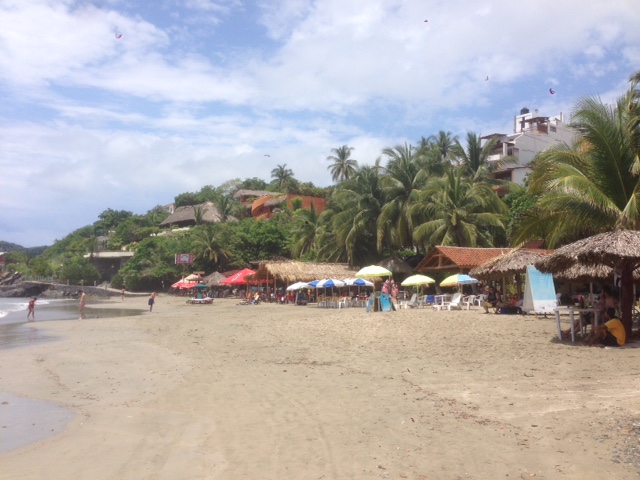
Tonight, after eating mediocre pizza for dinner (Pizza! In a Mexican fishing village! Damn kids.) and drinking a strong margarita or two at one of those off the beach places, I was heading down for my last swim of the day and saw two of the guys sitting at the top of the public access steps drinking beer and smoking cigarettes, which is the universal language, so I stopped and with my idiotic Spanish told them we were leaving tomorrow and this and that. Before I knew what was happening - though, who am I to protest - we were sitting on the beach and C. and his nameless friend had gotten me a glass of beer and were waxing eloquent about a friend who gave surf lessons someplace, and another place for us to go, and all sorts of other things that I didn’t catch. Fortunately, R showed up with her new, tight bathing suit, which I love, and the two guys stopped paying attention to me and started talking to R, which was fine because she actually understood what they were saying and the conversation could be above the first grade level that I could offer.
Good thing, because it turned out to be quite an interesting conversation that I was left out of, though, I did have the important role of pouring the beer, which, if I was grading my performance, I passed with flying colors – yellow shirt and all.
Both C. and X grew up here. They like the trending of the city to tourism because otherwise they would fish. As a waiter, they make no salary, but earn 10 pesos on a hundred that they bring into the restaurant. On a good day, they can make 1,000 pesos. Some days they make 30 pesos. The two meals that we have had at the beach restaurants where they work (they work at competing restaurants) ran around 400 pesos. We tip 10 percent, because we heard that is the norm, but Cesar and X said typically they get a 15 peso tip or nothing at all, regardless of the total.
While I covered my feet with the cool evening sand, sipped beer, and watched the Pacific crash against the shore, they also talked about the narco-violence that all of us Americans have heard so much about. Both C. and X assured us that we were safe anywhere in Mexico – we would not be targeted. The value of tourism is recognized, and persons who rob or otherwise harass tourists are dealt with – apparently in such an unpleasant and final way by the cartel that it discourages others from having such thoughts. While this gave me some comfort, it also caused me some guilt, probably due to my Catholic upbringing, that our presence in Mexico might tempt some down and out hoodlum to hold us up for our measly belongings and thus meet an untimely end while wearing my shorts which hadn’t been properly washed in a couple of months.
C. and his friend do have some reservations about the gang culture in Zihua because El Tigre, the boss of the local trafficking business, has recently been jailed, permanently, they think, and it is unclear who will be his successor. El Tigre had proclaimed that no “propina” would be required for local businesses to operate, so for the last few years, what money came into the restaurant went into the pockets of those who had earned it, rather than those who purported to protect it. R is very familiar with this concept of protection money from her law practice, as several of her clients have sought asylum in the United States, or in Ecuador when she worked for a non-profit there in 2008, because they refused to cater to the demands of the gangs that ruled the streets. Of course, failure to abide means that you are out of business at best, or at worst, cut up and served as an entrée at the establishment of the owner that does abide. So, you either pay, or you go, or you die.
The other interesting thing that they talked about while I stared off into the darkening skies and wondered at R’s ability to carry on a grown-up conversation in another language, was something that I think is very relevant to consider amongst all the idiotic rhetoric spewing from a certain also-ran for the U.S. presidency – Mexican immigration to the U.S.
I’ve seen C. on the beach every day for a week trying to woo patrons into his restaurant, but also playing with his ever-present three-year old son. There’s no daycare while he goes to work – the boy is there with him, all day, on the hot beach. This is true everywhere we’ve been so far – the kids are there, at work, with their parent(s). Whether it is after school, or in lieu of school, the kids are there, helping with the trade that keeps the family fed and clothed, and hopefully, sheltered.
But C.’s point was that he wouldn’t trade any amount of money he could earn in the U.S. for the time he gets to spend each day with his wife – who granted, is a masseuse and probably knows a trick or two about easing tension – and his son. He related that his uncle spent many years in the U.S. and that his cousins always had new shoes and gadgets (a Walkman and even a cool pager – that only worked in the US so was useless except as a prop), but that ultimately, they resented that their father was not at home with them.
The suggestion that Latino immigrants are in the U.S. to rape our women, sell high-quality gateway drugs to us and our children, and take our jobs cleaning airport toilets, is embarrassing. In the first instance, I’m embarrassed that it even resonates with anyone, and second, I’m embarrassed that our Congress hasn’t done anything in umpteen years about fixing what everyone recognizes as an area that needs governance. It’s also demeaning to those who make the sacrifice to risk their own lives and families to emigrate.
The Latino immigrants do what they must, just as we would. They cross illegally because there is no way for them to do so legally, and they work long days at jobs no American wants so they can earn more money than they could at home and send that money home with the intention to provide a better life for their families. And the flip side, the side we don’t think much about, is that they are away from their families - sometimes permanently. They can’t go back for birthdays, holidays, or deaths. Their kids might grow up without them ever knowing them and all they have to show for their sacrifice is a pile of letters and cards from people that they are doing everything that they can for, just as we would for our families and loved ones, and that they want to know, but don’t.
Zihuatanejo - Our Beach Vacation
We've been in Zihuatanejo for a week. When we pulled up last Friday, the hotel manager, a retired rodeo cowboy named Nacho, quoted us a daily cost which was much more than we wanted to pay for a beach-view, two-bedroom apartment - something like 1,300 pesos (about $75) a night. After we protested, Nacho said, we have a custom in Mexico - negotiation. He took a seat on the edge of the coffee table. You tell me what you want to pay for the night, he said, and then I will counter with my price. If we can't agree, then we roll the dice.
After a little back and forth negotiation, we remained 100 pesos apart. Nacho took a big wooden die off the bookshelf and handed it to J. You are four persons, he said, if you roll that number, you pay your price. If not, you pay mine. When R explained what was going on to J, you could see the weight of the world settle on the poor boy's shoulders. He knows how we love a bargain, and he probably hates spending money more than any of us, so from his point of view, if anything but four came up he would have really let us down.
"You better roll a four," I told him to keep the pressure on.
J took a deep breath, tossed the die confidently in the air and caught it, and then spun it across the white, tile floor. We all watched it bounce, teeter on edge like a sailboat taking a sharp turn in a strong wind, and settle on . . . four! We all jumped, even Nacho, like we'd just won all the guacamole we could eat in a lifetime rather than saving $6 a night on our rent. But that's how things got started here and it's been just about that good since.
After knocking back a few shots of the tequila that I offered him, Nacho mentioned that if we stayed longer than the four nights we agreed too, he would charge us even less for each additional night. So here we are a week later - we can't pass up a bargain. Nacho was happy too, because, as he put it, he had brought his freedom. Even though he lost his commission for renting under the owner's asking price, the longer we stayed, the longer he could spend the days as he pleased and not have to stand in the street trying to get someone to rent the apartment.
Zihua, as it's called, is our first extended interaction with the working class. Who knows if Nacho really lost his commission. Maybe, but it didn't seem to concern him that much as he later offered us even more of a discount on the rent. Maybe he's got a nest egg to fall back on. I'm not sure others that we've interacted with do. Life seems very much to be a hand to mouth existence for the many who rely on others to buy their wares or food or services.
We negotiated with Jose, who we met on the street while he was buying a cold coconut drink, to captain a boat to take us fishing and snorkeling for 1,000 pesos ($60). Think about that. We met the guy while we were walking past a coconut stand, which was nowhere near the pier, and he pointed at a boat off in the distance in the marina and talked us into letting him captain it for us. Then we gave him 300 pesos as a deposit and got a little piece of paper in return that said we gave him 300 pesos. Then we walked with him to the place where we needed to rent snorkeling equipment for the four of us, and handed all the gear to him to store in the boat overnight. Then we treated ourselves to ice cream like we'd finally settled something that had been a problem for us for a long time. Would that ever happen in the States? Not a chance. We would probably have walked away from the guy thinking he spiked his coconut milk with rum. Instead, here, we had only a little doubt that he was the guy he said he was and would take us out into the bay to troll for fish and would not disappear with our deposit and snorkeling gear. It's just a different mindset on how business is run - everything is informal. For example, the waiters come into the street or onto the beach where you are building a sand castle to try to get you to come into their restaurant.
But back to the point - after Jose actually showed up the next day with the boat keys and snorkeling equipment, how much of our $60 did he take home? Not all of it for sure, but I think he made out okay. He kept most of the fish we caught, so he could either sell them, or more likely, eat them. We tipped him after we learned he had to borrow the boat. We invited him to eat lunch with us - which was the mackerel that J caught and that we brought to a restaurant Jose recommended for preparation, and that restaurant also gave him two Micheladas, a beer and tomato juice concoction I won't go near, as props for bringing our business their way. So, in the end, he walked away with some money, some fish, and a buzz. I know I'd be happy with those spoils.
During high season, Jose is an employee on the same boat, which does deep sea fishing trips and the type of trip we went on, depending on what gets booked each day. R asked if the money he makes during high season is enough to sustain him through the year and he said not really. He needs to hustle folks like us who are just out for a drink of cold coconut milk. Life is hard.
I gave a ten peso tip to the guy at the pier who helped us out of the boat. If he does that 100 times a day and everyone gives him 10 pesos, it's about $60. That's almost equivalent to someone in the U.S. working 10 hours a day at minimum wage. Think about that - 10 hours of work for $72.25. Here, if you earn $60 a day you may be at the higher end of the lower class pay scale. Come to think of it, I wonder how you even get that job as pier host. Is it based on an application or is it more like a giant king of the raft battle every morning amongst all the wanna-bees with the last man standing host for the day? The juice guy we met in Huetamo paid his employees about 150 pesos a day - that's almost $10. Seventy dollars a week. It may be enough to live on, but it's certainly not enough to get ahead on - to save and plan for the future as is so drilled into us in America as the goal to strive for.
One of the American couples we met who lives here is at odds with their parents who feel they are not doing enough for their future. The couple is making enough to live comfortably now, and are having a good time doing what they want to do, but apparently is not making enough to bank for the future. It's a lot of pressure put on us to make enough money for food, shelter, and Netflix now, and to save enough so that we do not have to pick half-eaten bagels out of the trash and sleep on subway grates later. Add children and a college education into the mix, and the daily outlook for fun begins to look even more bleak.
Do we feel privileged? A little bit. We could pay $24 for dinner like we did last night every night for a year and it would set us back less than $12,000. We saved more than that. We could pay the $42 a night we are paying for this place all year and it would come out around $18,500, slightly more than our Alexandria mortgage. We saved more than that, too. But it came with sacrifices. R is self-employed and I work for the government - money wasn't just falling around us from the sky. We planned for this; I drank Pabst Blue Ribbon for a while until I learned the brand was purchased by InBev, and then I drank Modelo until I learned it was purchased by InBev, and then I said the heck with it and started drinking more expensive and better tasting local micro-brews and tried to save money in other ways - I haven't purchased a new CD since Neil Young released Chrome Dreams in 2007. And I know we can eat and live more cheaply here than we have been - which is why, eventually, we are going to leave here. Probably Saturday.
But anyway, let's bring this thing back up from the depths of the deep subjects of which we have just scratched the surface. This is our beach vacation, after all. Things aren't supposed to get so heavy. We've been in the ocean everyday - several times. We've built amazing sandcastles with thick sand walls and sturdy sand towers and decorated them with shells, and rocks, and bottle caps, and watched from our balcony as people have deliberately stomped them back into the beach. Why do people feel compelled to tread on when they can walk around? We've had so much beach time, in fact, that our skin is peeling from our faces and bald heads from sun overexposure. Between my new haircut, which I love, and flaking skin, some would say my head was a mess right now.
We went fishing. Jose took us, and J reeled in a big mackerel. He was as excited about that as he was nervous about rolling for our rent. As we walked from the pier to the restaurant with our big mackerel in hand, people stopped and looked - no one had seen a mackerel that big, or at least not recently - and tried to be friends with us, the mackerel catching family, and we smiled and shook our mackerel at them and waved like the Queen of England.
We go to market and buy fruit - avocados and apples and plums and pineapple and peaches - and vegetables - radishes (big and red!) and broccoli and onions and tomatoes - and juice and fish.
At its heart, Zihua is a fishing village, and every morning the fishermen who have been out all night run their boats into shore (Literally. They line up to head full speed into the beach and pull up the propeller at the last moment before crunching the hull into the sand) to sell their catch which is a bunch of fish that I don't know how to say in English, but also includes swordfish, marlin,and Ronco, the local whitefish. There are also millions of anchovies splashing about in the bay, shouting here I am, come and catch me, and the fishermen come with their nets at all times of day to catch them, and the birds dive headfirst into the sea from the sky to eat them, and other fish stalk them from below the surface and eat them. We've decided life is hard, and probably short, for anchovies.
We've played cards using watermelon seeds - 400 of them from a single half-watermelon - as poker chips (it's a math lesson - probabilities). We've finally sorted out our iPod to contain music that the kids should know - like the Rolling Stones, Tom Petty and the Heartbreakers, and Frank Zappa.
We've had a mechanic check out Wesley after the hard slog through the mountains (clean bill of health), we've done laundry, and we've downloaded some of the things we've needed for the kids to be educated to the standards of the Alexandria Public School System, where they will return to school next year if we decide to go back.
And I've had time to reflect on some of the things we've seen and heard that I was too busy to think about when we were driving every day or every other day. And that's why you get posts like this that go on and on.
What we eat and other musings
In a word – food. In a Spanish word – comida. Before we left the States we made a final visit to Trader Joe’s in Austin, which is our go-to grocery store when at home in Virginia, to load up on all our familiars like the Blistered Peanuts, Z-bars, good cheeses, granola and High Fiber Cereal. Although we don’t have a lot of that stuff left, we don’t miss it (except for the cheese) because we’ve found plenty of food in Mexico to satisfy our palate.
For example, instead of the peanuts, we’ve discovered fried plantain chips: just as salty and cheaper! Instead of TJs’ freshly squeezed orange juice in a box, we get our juice freshly squeezed at a juice stand.
R, who is a notorious fruit-stand stopper, tells this story about a trip to Baja she took years ago where the group saw a sign for oranges, stopped, and found the largest bag full of the ugliest oranges one could imagine. Having stopped, however, they felt compelled to buy, and were rewarded with the sweetest trove of fruit; the sorry looking things putting their prettier, larger, American cousins to a tail between the legs type of shame. On our first day driving in Mexico we saw a sign for oranges and stopped, of course. The cold, orange juice the man was selling was so delicious that we also brought a dollar bag of about 30 ugly oranges, and in anticipation of the sweet nectar, struggled to peel one of the dang things, only to be disappointed with the sourest, stringiest, excuse of an orange. The bag was quickly cast into the corner of Wesley and we would occasionally throw disdainful looks at it. In optimistic moments, J or I would take the five minutes or so that it took to peel one of these sorry citrus and attempt to enjoy it, however, it was never a pleasant experience and we were always left feeling used. We couldn’t even feed them to someone’s pet guinea pig, which apparently only ate oranges. When we got to SMA, J squeezed the juice out of the last 20 or so with the juicer that Sean and Mittie had, added sugar and water, and we were finally rid of them, and felt somewhat validated for buying them in the first place because he made some pretty good juice.
Another early stop was at a street side vendor selling bean tacos. Coconut and J both loved them (me too – they were 10 pesos each) and now if they don’t like what we have for lunch or dinner, or if they are still hungry after eating lunch or dinner, I can make them a bean taco with the tortillas and can of refried beans that we always try to keep on hand. Sometimes I’ll add some leftover rice from a meal we’ve had or cheese if we have something that’s not this strange Mexican version of cheese.
Because we can cook in Wesley, we make frequent grocery store stops to provision our non-perishables. We also have a fairly reliable solar set up to power the refrigerator and can keep things like milk, beer, spaghetti sauce, and leftovers from previous meals. We’ve been buying returnable five-gallon jugs of purified water and filling our water bottles and keeping those in the fridge (cold water just tastes better than hot water does when the temperatures outside reach 40 degrees Celsius) and dumping the rest in Wesley’s storage tank where we can drink it out of the tap. We don’t drink the tap water at hotels, etc., but do brush our teeth with it. We’ve got an antibacterial vegetable wash that many Mexicans add to water for soaking fruits and vegetables before eating. No one has had a serious gastrointestinal problem, yet. R was feeling poorly for a few days earlier in the trip, which was ironic because in our past travels, she’s been the solid one. (Haha. Get it?) The kids haven’t complained, and have been fairly adventurous in their eating – Coconut especially so.
The markets are amazing – the variety of fruits and vegetables, the colors, the sounds and smells, the heat and dogs. And everything is for sale; meats, household items, hardware, toys, clothes, juices, prepared foods, and inevitably, there’s a three piece band set up cranking out the local favorites.
Each place we’ve been, the market has a different atmosphere to it, but each is such a local experience that I think wandering through the markets is my favorite part of traveling. Plus, I love loading up on the cheap fruits and veggies.
This morning at the market I got a beet and carrot juice for 30 pesos (almost two dollars) and for less than a buck, a shredded chicken with mole negro sandwich. (Mole is a chili sauce prepared a bunch of different ways depending on region and it’s pronounced “mo-lay”.) We also spent about $15 on: a pound of chopped beef (J wants meatballs), fresh fish from the pescadores selling their morning catch on the beach (R is going to make us tiritas, a local type of ceviche), lots of fruit and vegetables at market – including apples, avocados, limes, an onion, tomatoes, a pineapple, radishes, plums - and 4 fresh baked rolls. Avocados are especially cheap – we can buy three or four depending on size, for a dollar. We are a mango eating family and we are right at the end of mango season so we’ve enjoyed our share of those as well. (On the other hand, we’re also a watermelon eating family and we will likely not buy another. Unlike the US where fruit is GMO’d to our perfectly bland and seedless preference, the watermelons here are full of pesky seeds and we all hate eating them, though we have found a good use for them - watermelon seed poker chips!)
Our first few days in Mexico had us wanting to eat local food but finding it difficult to know what street-side eateries were rundown-looking yet open and which were rundown-looking and closed – there isn’t much difference and only occasionally does the presentation of a place seem to be given any consideration by the proprietor. If we stuck to our ingrained programming of fresh paint and landscaping before considering whether to dine at a particular establishment, we might starve. Fortunately, we also learned before we tried it, that “barbacoa” isn’t the succulent meat grilled over an open fire with a sticky sweet sauce that it sounds like. Instead it’s some kind of cow face stew (cow cheek, cow tongue, cow forehead, cow brain). Though, I may still consider sampling it if the restaurant looks nice.
If we can’t find a roadside stand or lunch counter for eats, it’s still pretty cheap to sit in a restaurant. The most we’ve paid for a meal for the four of us is about $35 – and that was more food than we could eat. We usually bring along a Tupperware or Ziploc for the extra rice and beans and tortillas that come with every meal. At the restaurant attached to our Los Azufres camp, where R and I had trout, Coconut had the steak, and J had the chicken, the cook/waitress kept bringing us food even after our plates where cleared and we had the Uno cards out. That meal cost $18 so we did it again the next night.
Being here at the beach has opened up a new food option – seafood! We’ve brought fresh fish at the beach each morning and I learned how to clean and gut a fish, which was easier and smellier than I thought it would be. I saved the fish guts for J and I to use as bait for fishing from the pier. We didn’t catch any fish, but the flies sure liked it. We’ve booked a fishing/snorkeling excursion for tomorrow and the guide will cook whatever we catch. Since J doesn’t eat fish, he is already making plans to sell any fish that he catches. I’m excited by this entrepreneurship, and he’s even offered to sell them to me at a five peso discount since I’m his dad and am paying for him to go on the trip.
The curious thing is that despite the abundance of fresh fruits and vegetables - we've heard even regularly grown crops are more organic here than the organic products at home due to the utter lack of pesticide usage and the reduced-to-zero chance for run off - meals are lacking in these homegrown products. Sometimes a meal will come with a small iceberg lettuce or shredded cabbage salad on the side with onions, and cucumber and tomato slices, but that's about it as far as it goes for a vegetable option. It is not safe to be an animal here, however, as every part of you will get eaten.
The proliferance of meat as the meal, supplemented with carbohydrate-rich rice and beans, as well as the abundance of fried foods - don't forget, even a seemingly healthy chicken taco comes in a fried tortilla - may account for Mexico recently claiming the title of most obese country in the world. And it is fairly obvious, especially amongst the women. Although portions are generally small, the amount of food that comes with a meal often pushes it over the limit of what is necessary to consume to feel full. An enchilada platter, for example, will have three or four enchiladas stuffed with chicken, side salad, rice, beans, tortillas, and may come with a sweetened juice or soda. There's not a lot in that meal that would make your mother happy except maybe the low cost. Stores are full of packaged junk food and it is fattening both the pockets of the bosses of the multinational corporations and the bellies and asses of the public. Just like in the States.
There are signs a public education campaign about healthy diet and exercise may be reaching the middle class masses, at least. In the beach town of Zihuatanejo, which at the moment seems to attract mostly Mexican vacationers rather than American or European gringos, the streets are crowded with early morning joggers and I have seen others using heavy stones as weights. In Hidalgo, nearby the La Posada campground where we stayed, there was exercise trail equipment that people actually used as more than a tableau for graffiti.
Seeing this has been both an inspiration to me, I've been guilted into going jogging a few times, and an albatross, I've gone jogging only a few times. Perhaps because we've been mostly mobile we've failed to establish a regular exercise routine which is something I really thrive on at home as much for the mental benefits as well as the obvious physical ones. We have been fairly active between rock climbing, walking around town, and getting pummeled by the Pacific surf, so we are not totally out of shape and soft yet, but I think a more regimented routine of stretching and resistance movements for the less active days would do us all good.
Up and Down the Sierra Madre and the Butterfly Massacre
We left Los Azufres early Thursday in anticipation of a long drive to the Pacific Ocean that we would be able to complete in one day. Silly us. We finally arrived in Zihuatanejo (Zihua, to the locals), in Guerrero state, on Friday afternoon at 6 p.m. after driving back to back 7-hour days - in which we broke two of our road rules, not to drive longer than four hours in any one day and not to drive consecutive four-hour days. The entire distance was less than 300 miles, but our map is not topographical and no one told us our chosen route - route 51 to route 134 - required us to climb and descend two spurs of the Sierra Madre mountain range - the Sierra Madre Occidental (West) and the Sierra Madre Sur (South). Let me tell you, these are big mountains and we climbed most of the way in second gear, with an occasional downshift to first gear, and we descended most of the way in third gear, with an occasional downshift to second gear, for the numerous "curva peligrosa" - dangerous curves.
It happened at Los Azufres
We've each challenged ourselves to learn one physical and intellectual skill during this year abroad. For example, R wants to learn the night sky as her mental challenge and J wants to learn how to surf. Coconut wants to read 100 books.
My physical challenge is to learn to juggle a soccer ball on my feet at least ten times without it hitting the ground which may not seem like much of an accomplishment but soccer didn't even exist as a sport when I was in high school in NJ in the 1980's so it's basically the equivalent of a kid today learning how to ride a broomstick so she can try out for the local Quidditch team.
Wednesday morning as I was practicing in the field by our camp, I kicked the ball over the hedgerow. When I peered over the bushes to see how easy it was going to be to retrieve the ball, I saw the ball rolling down the embankment to a very narrow but fast moving creek. I quickly burst through the hedges, good thing I had put on long pants, and ran downstream to see if I could intercept the ball before it floated to Mexico City. As luck would have it, the ball had gotten stuck in the eddy of a small waterfall.
Great! I wouldn't have to shell out 30 pesos for a new ball, but I was going to have to wade into the creek to get our ball. This is where putting on long pants in the morning backfired because the pool was deep and there was no way I could hitch my pant legs up high enough to avoid getting them wet.
After a quick look around the camp ground and pool area - it's good that we camp at places like this during the week when the rest of Mexico is at work - I took off my shoes and pants - leaving me barefoot and spindly. After contemplating the bank again (must everything in Mexico be so darn steep!), I was pretty sure I could get into the creek, even if it meant falling in with thorns in my soles, but I was less sure I could get out again.
After a few calls for help to my family which was huddled around their screens at camp, they finally came to my aid long after I would have drowned or been eaten by a bear if I had been in any real need of help, and were reduced to tears by this vision of the morning.
After they had gained their composure again, R and J teamed up to dislodge the ball from its resting place while I waded in at a shallower spot which would not have required me to remove my pants if I had thought of it in the first place and waited for the ball to take its short whitewater journey to my waiting hands.
San Miguel de Allende . . . and beyond!
We arrived in San Miguel de Allende on Friday, September 5 and left on Tuesday, Septmber 8. It's hard to keep track of the day and date when you're untethered like we are, but it's helpful to know in case a store or restaurant might be closed or whether a certain market is happening.
It's also necessary for us to know the date because we aren't completely untethered - we have plans to meet R's parents in Belize on October 2 so we are making a mad dash across 1,400 miles of vast and culturally diverse Mexico to arrive on time.
One place we do want to visit before we say adios to Mexico is Chichen Itza, which, it turns out, is a Mayan city and not a way to prepare chicken, for the autumnal equinox on September 22 when the sun will strike the temple El Castillo - so named by the Spaniards - in such a way that a serpent carved into the steps will appear to slither to the ground - something the Mayans actually planned and not a bit of architectural and astronomical dumb luck as has played such an instrumental role in shaping my own life. But more of that at another time.
Today, Wednesday, September 9, we spent the day at Erindira in Los Azufres, which is a park about 60 kilometers east of Morelia in Michoacan state. It's fairly close to the middle of the country, but a heck of a lot prettier than Oklahoma - no offense to any Oklahomans who may be reading this. Erindira is a hot springs and campground in a pine forest near a trout farm and at some high elevation, and it was all Wesley could do in second gear to climb the mountain to get here. Heck, it was all we could do to find our way here without a GPS or a map that has all the route numbers and town names marked on it, and R and I were about as far apart as you can get while sitting right next to each other and arguing whether to take 51 through Celaya, or 45 towards Mexico City, or 120 to Acambaro, or 43 towards Salvatierra, all of which might lead to some road that might lead to here. Of course, this happened just after R mentioned how well marked the roads were and I agreed.
Anyway, we made it before dark and set up camp and I slept in the tent by myself - kind of like being put in the doghouse. We had a lazy day today in anticipation of a long push towards the Pacific Coast tomorrow. We went for a soak in the various hot tubs in the morning and then came back to camp and did some schoolwork - I now am solid with polygons and can approximate how many tourists visit the White House in one year - and then strapped on our shoes to take our first hike in Mexico to visit the trout farm which is up 138 steps leading into the forest, through a barbed wire fence, and down a dirt road with a creek running across it which is narrow enough to jump over. This is how Coconut and J gain perspective on the world.
J has made two fishing poles on this trip after he watched a few YouTube videos about how to make a pole and he's been patiently waiting to use them. He was hopeful that we could fish at the trout farm but even after we carried them all the way there, it was no dice. We hung around at the farm for awhile anyway and watched the fish swim in circles while one of the holding tanks was cleaned. Signs advertised that the fishery (how can it be a fishery if you can't fish? Doesn't one nurse at a nursery? Eat at an eatery? Bake at a bakery?) was recognized as a place that raised trout in a way that was environmentally helpful to both the fish and to humans and R and I would agree after we had a couple of them for dinner.
We spent our time in San Miguel de Allende at Sean and Mittie's house regrouping, soaking up the hot showers, and throwing a bone over and over again to their dog Switters. R and Sean volunteered together in Guatemala in the last century at a non-profit development agency and reconnected recently through the magic of Facebook. Sean has been living in SMA for almost a decade, making money as a professional photographer, and partnering with Mittie as an adventure travel team. I recommend you check out what they are up to at www.seanandmittie.com because it's pretty inspiring - they planted more than a few seeds in the fertile valleys of R's and my brains. We really appreciate their hospitality in letting us take over their house for a long weekend, and thank them for introducing us to the "Cubano" sandwich at the shop with the green door. If you eat one of those every day, and order the green juice which includes parsley, you will grow old and happy.
Another super cool thing that happened was that Sean took a bunch of photos of Wesley in different "poses" that looked really great and we can't wait until he's done editing so that I can finally write up a blog post about how Wesley is outfitted and how we manage in it day-to-day.
I've heard about SMA for a number of years as an American retiree community and we saw our share of viejo gringos at the farmer's markets, upscale clothing boutiques, and just around. Sean said that if you were looking for a non-immersive Mexican experience, you could find it in SMA.
Of course, that's not what we are looking for and the cobblestone streets, local markets, and tiled walls and houses give the city a real colonial look and feel. The other "Mexican" thing about it is that you can rent all-terrain 4-wheel vehicles and drive them around the city streets in traffic - which we did - on a tour that also took us out into the corn fields surrounding the city and up into the hills for a view over the lake and city.
A few weeks ago, or maybe just a few days ago, I've lost track, Coconut and J saw that you could buy a 4-wheeler at Wal-Mart for less than $1,000 (we figured out the conversion from pesos) and Coconut is in the process of writing a persuasive essay as to why we should buy one and ship it to her grandfather's lake house. I'm already convinced and I haven't even read her reasoning yet, but I know that after she and J were allowed to drive our rentals around - something I am certain they would not have been able to do in the States - I could probably get them to kick in some money towards the cost of buying one. They had a blast.
